07
The Coastal Birds
by Douglas Bertram
Strait of Georgia Habitats Essential to Migratory Birds
Bird Groups
- Loons, Grebes and Cormorants
- Herons
- Waterfowl
- Raptors
- Shorebirds
- Gulls, Terns and Jaegers
- Alcids
- Other Birds Affiliated with the Strait
Bird Population Trends
- Winter Bird Counts
- Spring Migration Counts and Observations
- Summer Breeding Bird Counts
- Identifying the Causes of Population Changes
- Threats to Birds from Humans
- Table 1. Potential and known threats to birds
- Legal Protection and Conservation
- Ownership of Terrestrial and Marine Habitats
- Table 2. Legal acts, application to birds and their habitats, and responsible agencies
- Conservation, Stewardship, Restoration, Research and Monitoring Efforts
- Conclusion
Table 3. Coastal birds of the Strait of Georgia
Strait of Georgia Habitats Essential to Migratory Birds
Migration, breeding, moulting and wintering are all parts of the annual cycle that drives bird lives, and millions of birds utilize the habitats provided by the Strait of Georgia to meet these critical needs. Some, like western sandpipers, long-distance migrants that breed in Alaska and winter in South America, refuel their bodies on the bountiful mud flats of the Fraser River delta as they move north in spring and south in the fall. Other birds, like the Barrow’s goldeneye, a diving duck, breed on inland lakes, moult on another distant lake, then return to the strait to spend the winter feeding on mussels and clams. Still others, like the marbled murrelet, which feed on small fish and krill, may spend the entire year connected to the strait.
The aquatic habitats of the strait include major estuaries and deltas, sand and mud flats, beaches and shallow bays, steep-walled fiords, and hundreds of small islands and islets, which provide a wide range of food sources. The numbers and variety of bird species attracted to them fluctuate according to the season but are generally higher during winter and spring migration and lower in the summer. In March and April sea ducks can be seen bobbing their heads and posturing while they court and form pair bonds prior to heading to the nesting grounds. Sandpipers are drawn to mud flats, which host tiny invertebrates; goldeneyes prefer the shallow bays and coastlines, home to mussels and clams, and brant geese feed on the eelgrass beaches near Parksville. But when the herring spawn in March, nearly all of the waterbirds in the strait gather to eat the eggs, many species travelling some distance to the spawning zones.
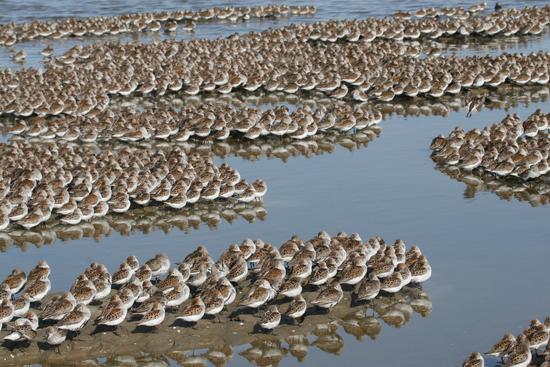
Bird Groups
This chapter looks at eight groups of birds that visit or occupy the strait: loons, grebes and cormorants; herons; swans, geese and ducks; raptors; shorebirds; gulls, terns and jaegers; alcids; and other birds (table 3).
Loons, Grebes and Cormorants
Loons, grebes and cormorants are all diving birds that propel themselves underwater with their feet in search of fish prey. Loons are among the largest of these waterbirds. The common loon, which is featured on the Canadian dollar coin or “Loonie,” winters in the strait and is found along the coastline throughout the region. These birds often feed alone on forage fish such as herring and can frequently be seen from the Tsawwassen ferry jetty. They nest primarily on the shores of freshwater lakes and produce a clutch of 1–3 eggs. The Pacific loon breeds on Arctic and subarctic lakes in Canada, Alaska and Siberia. This loon feeds on forage fish between September and May and can be seen in feeding flocks of up to 50 birds at the entrance to Active Pass at the northern end of Mayne Island. This gathering is the result of the currents created just north of the entrance to the pass by features of the ocean bottom (bathymetry) that concentrate shrimp-like prey called krill (euphausiids), and the krill in turn attract forage fish, such as herring. Pacific loons are also commonly seen during the March herring spawn events. The red-throated loon is also a winter resident and is often found at the mouth of the Fraser River. Like other loons, it is a fish-eater, but unlike them, it will nest on freshwater lakes near the coast and visit the strait only to forage. There are a few breeding records for red-throated loons in the Strait of Georgia.
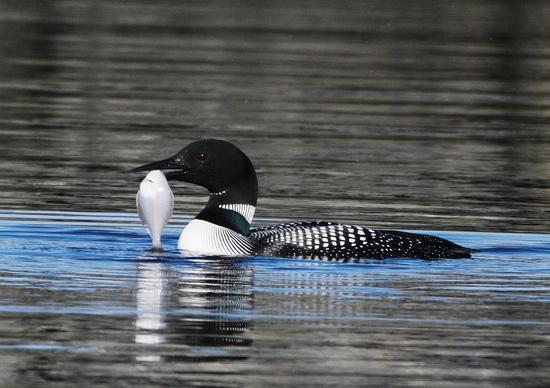
The western grebe is the largest of the grebes found wintering on the strait, but they breed on freshwater marshes far inland, with their main breeding population on Lake Manitoba at Delta Marsh, Manitoba, one of the largest freshwater wetlands in Canada (fig. 1). The mating ritual of the western grebe, which involves the pair running side by side on the water, has been well photographed. Since the 1970s wintering western grebes have declined by 81–95 percent in the Strait of Georgia and adjacent Puget Sound, while declines have also been reported in freshwater breeding colonies in British Columbia and Alberta. Recent collaborative research between Environment Canada, the University of British Columbia (UBC) and Simon Fraser University (SFU) has examined this decline within their entire wintering range from California to British Columbia and shows the overall decrease to be up to 50 percent. It also indicates that a larger fraction of the western grebe population is now wintering in California and that the redistribution patterns could be related to large-scale ocean production fluctuations within the California Current Ecosystem, which impact the cycles of sardine and anchovy prey populations. This species has recently been assessed as Special Concern by the Committee on the Status of Endangered Wildlife in Canada (COSEWIC). See table 3.
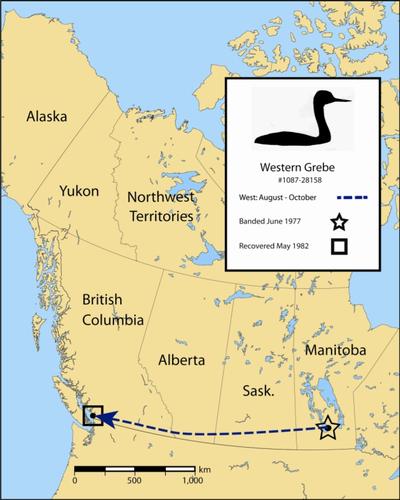
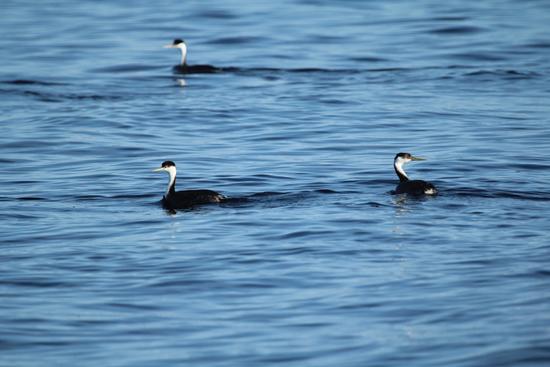
The red-necked grebe and the smaller horned grebe are commonly observed in the strait between August and March and can often be seen in Boundary Bay diving for small fish. Both species breed on inland lakes in British Columbia and from Alaska to Ontario; like all grebes, they carry their young on their backs. Wintering popula-tions of both species have declined in the Strait of Georgia and Puget Sound, and the horned grebe was recommended as a spe-cies of Special Concern by COSEWIC in 2009. The pied-billed grebe can be found wintering in protected salt water in the strait. It breeds locally on freshwater lakes on Vancouver Island and the mainland coast and has been recorded breeding in city parks in Vancouver and Burnaby.
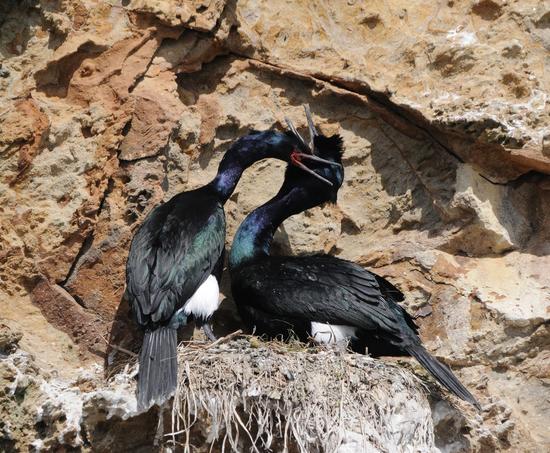
The pelagic cormorant, the smallest and most agile of the cormorants, is a year-round resident of the strait. It breeds in colonies on small ocean islets where there are no mammalian predators; according to a count by Trudy Chatwin in 2010, 6-ha Mandarte Island in Haro Strait has the largest colony with 558 nesting pairs. They prefer to nest on steep terrain or cliffs where the nests and roosting areas are notable (and smelly) due to the white guano accumulation. These birds, which lay a clutch of 2–5 eggs, are very sensitive to disturbance while breeding. Adults feed the young in the nest for 8–10 weeks, diving for food around the nesting colonies and regurgitating bottom-dwelling fish such as gunnels, blennies, sculpins and Pacific sand lance. In the winter more pelagic cormorants arrive from as far away as Alaska. They are commonly seen near ferry terminals, often standing on pilings and navigational buoys.
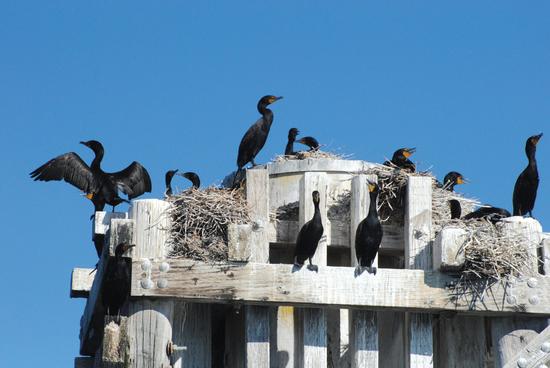
The double-crested cormorant, the largest of the resident species, often breeds in the same colonies as the pelagic cormorant, though in separate locations. The parents construct an elaborate nest from branches and seaweed that can be as large as 0.9 m high and 0.7 m across located on pilings or in trees. When, over time, the trees die or fall, the birds continue to nest there, though on the ground; this is the case for most of the nests in the strait. Double-crested cormorants usually lay 2–4 eggs but can produce up to 11. Adults feed the young on bottom-dwelling fish like gunnels, shiner perch, snake prickleback, Pacific sand lance and shrimp. In 2009, there were 403 nesting pairs in the strait with the largest colonies on Mandarte Island and man-made structures near Crofton. The number of wintering birds in the region has increased significantly due to population expansion from Oregon where recent satellite telemetry studies have allowed their movements to be tracked on East Sand Island at the mouth of the Columbia River, the site of the largest-known nesting colony of double-crested cormorants in the world.
Brandt’s cormorant does not breed in the strait, but they are found wintering here from the south. They are gregarious, and large flocks can be seen in areas of high current, such as Active Pass, where fish and shrimp prey are concentrated.
Herons
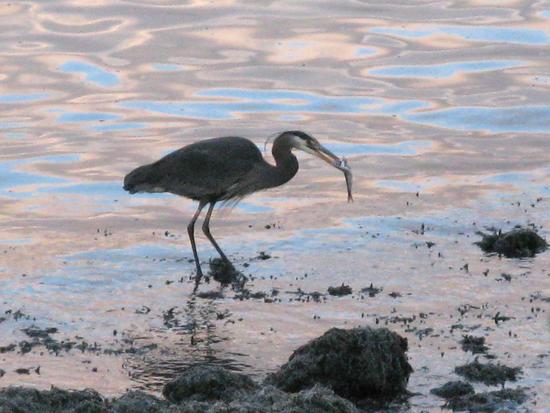
The great blue heron stands a metre high and is the most conspicuous wading bird in the region. Heron subspecies (fannini) are resident in the Strait of Georgia, a hotspot for breeding. The birds nest primarily in tall, dying or dead trees, either as a single pair or in colonies, such as at Point Roberts where in the year 2000 up to 350 pairs nested. Nests usually contain 2–3 young, which are ready to fledge in about 60 days. However, heron nests and colonies are very sensitive to disturbance, especially to attacks by bald eagles, which eat the young. This is a growing problem as bald eagle numbers have increased considerably over the last 20 years. In summer the parents may be seen fishing the shallow waters near the Tsawwassen ferry jetty. The majority of prey is shiner and herring during the spring spawning period, but herons will take almost anything they can capture or stab with their large dagger-like bills; they frequently eat rodents on land. The Canadian Species at Risk Act currently lists the great blue heron as a Special Concern.
Waterfowl
Geese, swans and dabbling ducks
Geese, swans and dabbling ducks do not dive, and although they spend time on land, they also require estuarine, marsh and shallow intertidal habitats; this attracts them to the Strait of Georgia where they eat plant material that they can forage without diving underwater. Many were historically over-hunted and their decline contributed to the signing of the Migratory Bird Convention in 1916 by Canada and the US; today geese and swan populations are large and continue to grow.
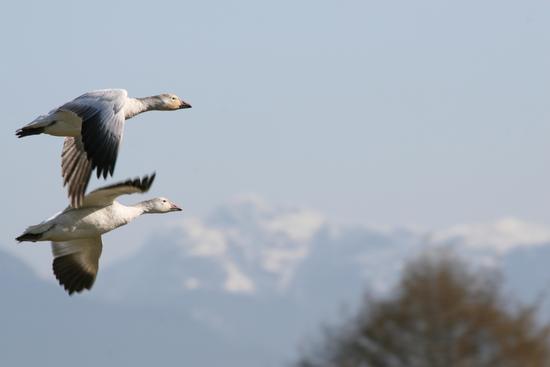
The Wrangel Island lesser snow goose breeds in the remote Arctic on Wrangel Island, Russia, a biologically rich wilderness that was declared a World Heritage Site in 2004, but the majority of the snow goose population winters on the delta of the Skagit River in Washington State and the delta of the Fraser in British Columbia. This population is a conservation priority for the Pacific Coast Joint Venture, which has undertaken several projects over the past 15 years to improve wintering habitat, often by supplementing winter crops on agricultural land. The birds also forage extensively on bulrush in the delta marsh areas. Research conducted by Sean Boyd of Environment Canada indicates that recent breeding success together with declines in sport harvest have contributed to an increase from 60,000 to 100,000 birds over-wintering on the Fraser River delta since 1987. Unfortunately, the increased feeding pressure of these flocks has contributed to a 60 percent decline in the density of bulrush during that period and, if similar declines continue, bulrush could be lost from much of the delta within the next 20 years.
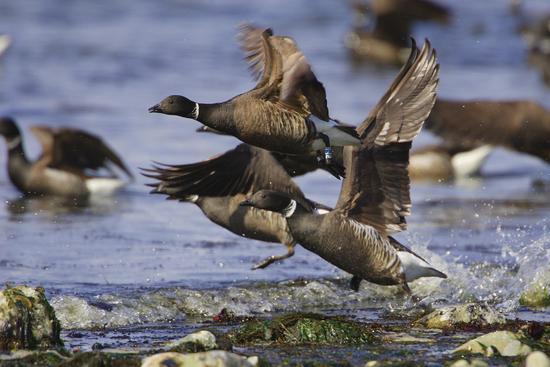
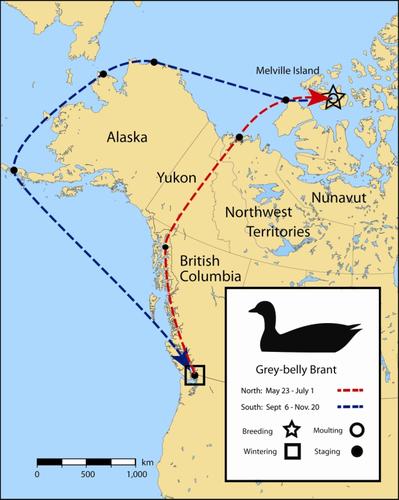
The brant goose is sometimes called the “sea goose” as it is rarely seen far from salt water. Brants are common, localized residents on the Fraser delta in winter, but their numbers increase greatly during spring migration when more birds arrive tired and hungry after flying directly from wintering grounds in Mexico. In March and April the annual Brant Festival in the Parksville-Qualicum beach area observes 3,000–6,000 migrating birds stopping over on their way to their breeding grounds on the High Arctic tundra, which is reached via Izembek Lagoon, a National Wildlife Refuge on the Alaska Peninsula. Six to ten thousand grey-belly brant geese spend the winter in Samish and Padilla bays at the south end of the strait; satellite telemetry by researcher Sean Boyd shows they migrate south from nesting and moulting sites in the Canadian western High Arctic along coastal Alaska to the Aleutian Islands, and finally across the Gulf of Alaska to the Strait of Georgia region to spend the winter (fig. 2). In the strait the brant graze at the tideline on leafy marine vegetation such as eelgrass and algae, and when herring spawn attaches to this marine vegetation the increase in diet quality helps to fuel their bodies. The 35 percent increase in body mass gained during migration sustains them through the breeding period, but this increase can be difficult to achieve when they are interrupted from foraging by people, dogs and eagles.
The Canada goose was introduced to the mainland and Vancouver Island in the 1970s, and large populations now remain year-round. They forage on shorelines and estuaries, and large populations of them can have a heavy impact on marsh vegetation. Recent research in the Little Qualicum River estuary estimates that 17 tonnes of sedge are lost each year to “grubbing” by Canada geese. The Guardians of Mid-Island Estuaries are now assessing the impact of the Canada goose on the Englishman and Little Qualicum estuaries and attempting to rehabilitate affected marshland.
The trumpeter swan is not commonly seen on the ocean but is occasionally found in marsh and estuarine environments along the strait. This species was close to extinction in 1933 with fewer than 100 birds left in North America. However, in 2000, when nearly 40 percent of the Pacific coast trumpeter swan population wintered along south coastal BC, particularly on Vancouver Island, the continental population was estimated at 23,600 birds.
The many large estuaries along the Strait of Georgia are important places for dabbling ducks to winter, and the extensive estuarine and marsh habitats of the Fraser River delta attract hundreds of thousands from a variety of related species. Other major estuaries important for dabbling ducks include the Cowichan, Chemainus, Nanaimo, Englishman (Parksville–Qualicum), Little Qualicum, Comox and Campbell rivers on Vancouver Island together with Squamish and Powell rivers on the mainland.
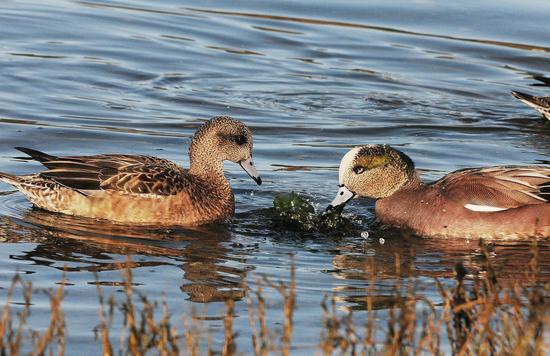
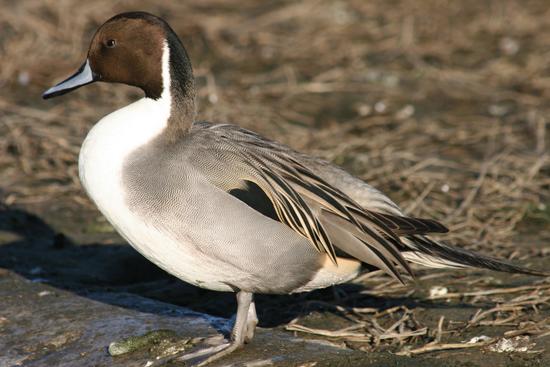
Dabbling ducks are easily recognized because, when frightened, they spring directly into the air instead of taxiing along the water. They have poor diving abilities so they feed in shallow waters, often in mixed flocks, primarily seeking aquatic and salt-marsh vegetation (grasses, sedges, forbs), tubers, seeds and marine algae. Some species will also consume animal material, including small invertebrates, fish eggs and larvae. Most species are actively hunted, and considerable effort has been devoted to securing sensitive freshwater wetland nesting habitats as well as moulting and wintering habitats for them. Between 1990 and 2010 partners in the North American Waterfowl Management Plan have secured four million hectares of waterfowl habitat, and most populations are now considered stable or increasing.
The estuary of the Fraser has the highest densities of ducks due to its extensive brackish water marshes, eelgrass beds and nearby farmlands on which waterfowl feed. Extensive surveys in 1996 by the Canadian Wildlife Service and Ducks Unlimited estimated 340,000 dabbling ducks wintering in the Fraser River estuary. The most abundant species were American wigeon (38.6 percent), northern pintail (33.1 percent), mallard (23.9 percent) and green-winged teal (2 percent) with the remaining 2.4 percent made up of gadwall, northern shoveler, blue-winged and cinnamon teal, Eurasian wigeon and wood duck. American wigeon are herbivorous and feed on the introduced eelgrass and appear to avoid the native plants in the intertidal areas during the day, moving to the farmlands of adjacent Delta Municipality at night. They breed in interior wetlands all across North America and return along the Pacific Flyway to the Strait of Georgia during spring migration. The northern pintail, mallard and green-winged teal are omnivorous and supplement their consumption of eelgrass with gastropods, bivalves and amphipods. As the season progresses from fall to winter, these birds switch from feeding in intertidal areas to adjacent farmland, which is an important component of coastal habitat. However, extreme cool winter temperatures can result in ice cover on marine bays and flooded farmlands, forcing dabbling ducks to leave the Fraser delta for alternative wintering sites. Northern pintail breeds from the Arctic to middle latitudes in North America and Eurasia; it is the most abundant duck on the Pacific Flyway. Mallards are the most common duck throughout BC as well as the most important game duck. They reside in the Strait of Georgia and nest throughout the province and the northern hemisphere from the subarctic to subtropics. Green-winged teal breed throughout BC and the middle latitudes of North America and Eurasia to the Arctic.
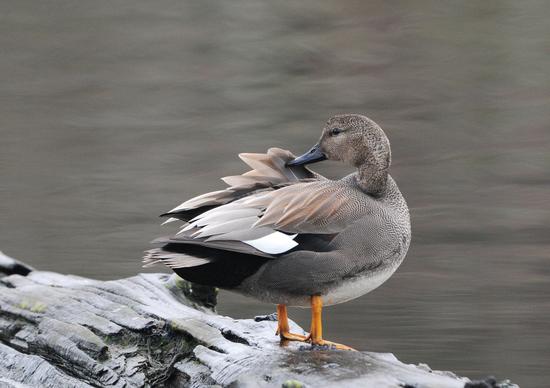
[To Top]
Diving ducks
The Strait of Georgia is home to fourteen species of wintering and migrating diving ducks, species that use their feet, wings or both for propulsion while underwater. Several of these species also moult in the strait and become flightless for a short period. Like other ducks and geese, the males do not share in incubation duties, allowing them to migrate before the females and thus arrive at moulting and wintering areas earlier in the season. During winter and prior to migration, ducks will exhibit courtship behaviour and form pair bonds. The young are mobile and can feed themselves right after hatching (precocial).
Diving ducks have a wide variety of lifestyles and habitat requirements and are flexible to changes in the availability of prey, though in spring most species seek out and prey heavily on herring eggs. In the strait the highest densities of diving ducks are found over the broad and shallow shelf of the east coast of Vancouver Island, but they are also common in the intertidal zone of estuaries, in shallow bays and along rocky marine coastal shorelines. They include a large group called sea ducks, which are dependent on marine habitats for part of their life cycle. Following the Exxon Valdes oil spill in Alaska, the Canadian Wildlife Service, United States Fish and Wildlife Service and the United States Geological Survey developed a Seaduck Joint Venture, approved in 1998, prompting new research on the importance of the Strait of Georgia to wintering sea ducks.
Regionally, there are eleven species of sea ducks. The largest of them—the surf scoters, white-winged scoters and black scoters—dive using both the feet and wings and almost exclusively consume animal prey. They winter in the strait by the thousands, feeding on mussels and barnacles (in rocky habitats), clams (in sandy or muddy habitats), gastropods, herring spawn, polychaetes, crustaceans and small fish. Typically they are found near shore in shallow water (less than 10 m), but they are also abundant in the deep fiords connected to the strait. They are gregarious birds and feed in large fl ocks, often in association with other sea ducks. They will adjust feeding locations and the time spent feeding, according to prey density and distribution. For example, when mussels and clams are depleted over the winter due to heavy feeding, scoters switch habitats to feed on crustaceans living on seagrasses. They are known to move toward concentrations of ephemeral prey such as polychaete worms, but particularly striking is their attraction to herring spawning areas in the spring. Satellite telemetry studies indicate that the scoters time their migration to the movement of the herring, which spawn later in the north than the south coastal regions. In 1978, an estimated 300,000 migrating surf scoters congregated in Big Bay on the east coast of Vancouver Island near Denman Island in time for the herring spawning there. Herring eggs are superabundant and allow the birds to fatten quickly, giving them more time for spring courtship and the formation of pairs prior to breeding.
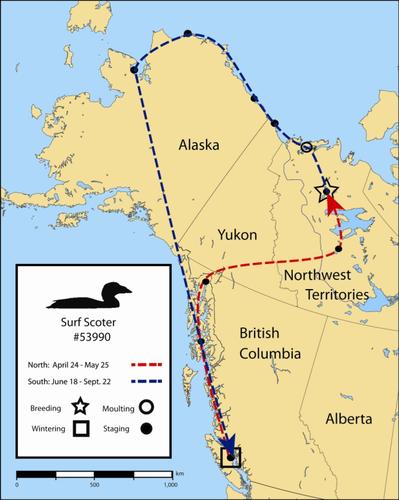
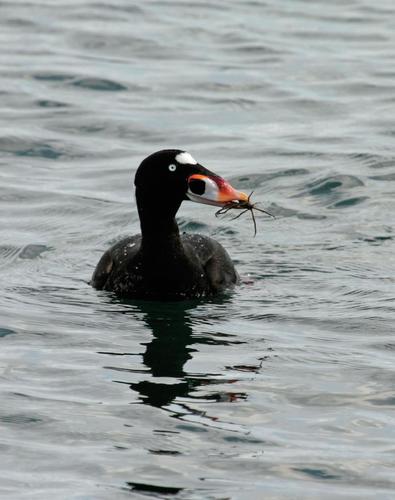
Surf scoters have been tracked as they move from the Strait of Georgia, then up the coast of British Columbia and on to their breeding grounds in the boreal forests of the Yukon and Northwest Territories. Whitewinged scoters also move up the coast during herring spawning season before heading to breeding grounds in the Northwest Territories (fig. 3), while black scoters, which are uncommon in the strait, appear to stick to the coastal regions during spring migration all the way to Alaska where they breed on lakes in the boreal forest and on wet tundra. After breeding, both white-winged and surf scoters return to marine waters to moult fl ight feathers; Boundary Bay is one of their important moulting locations. It is during this period when the birds are flightless that they can be readily captured and banded by wildlife researchers.
Aquaculture of mussels, clams and oysters is a growing business in the Strait of Georgia, and there have been concerns about interactions between scoters and these shellfish culture operations. Scoters have certainly been attracted to shellfish aquaculture farms where oysters are suspended in the water column. However, a study led by Ramu¯nas Žydelis showed that large numbers of the preferred prey—wild mussels—grow on the aquaculture structures near the Malaspina Peninsula and lead to positive effects on scoters. In Baynes Sound the shallow waters attract wintering scoters because of the dense clam beds on the ocean floor, but over the last two decades on-bottom aquaculture for the introduced Manila clam has caused concern that scoter numbers could be negatively impacted. In the 1990s another introduced species, the varnish clam, took hold in Baynes Sound and it has benefitted scoters by becoming a major component of their winter diet.
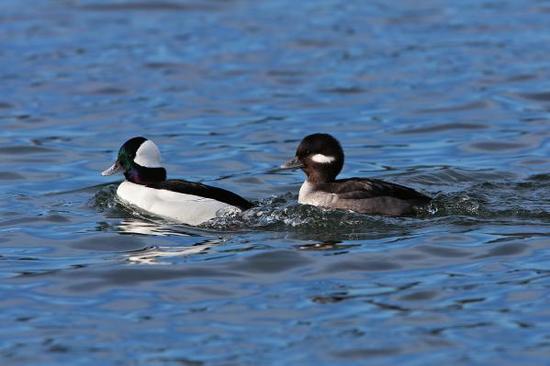
The duck genus Bucephala includes the Barrow’s goldeneye, common goldeneye and the bufflehead, the smallest of ducks. In winter all of them are commonly found in the strait’s bays, inlets and harbours, and along its rocky shores, while large wintering populations of Barrow’s goldeneye occur in the mainland fiords connected to the strait. Historical surveys estimated approximately 4,100 Barrow’s goldeneye in Jervis Inlet during the spring of 1977. All three species feed primarily in shallow water (less than 5 m) on mussels, clams, crustaceans, snails and small fishes as well as herring eggs during the spring spawning. They occur together in small to medium-sized flocks but form large concentrations with other sea ducks during the overlap of spring migration and the herring spawning season. Goldeneyes and buffleheads breed at interior freshwater lakes and sloughs and nest there in tree cavities, though they will readily use nest boxes. They are very competitive and defend their nesting territories aggressively.
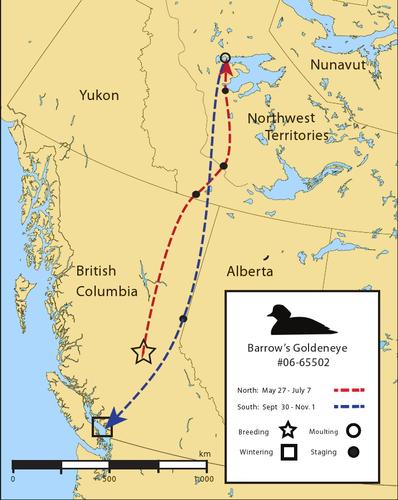
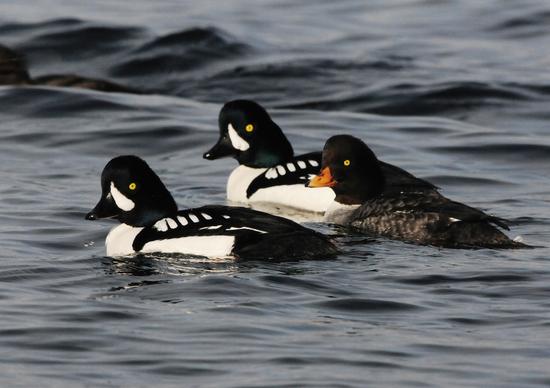
Populations of all three species are considered stable. For Barrow’s goldeneye, the global numbers are relatively small, and the majority will breed and winter in northwestern North America. Consequently, they have attracted the attention of satellite tracking studies, which can provide detailed information on migration and habitat use patterns. A number were captured and outfitted with small satellite radio transmitters on their breeding grounds at Riske Creek, near Williams Lake, BC, led by Sean Boyd of Environment Canada. Tracking indicated that most of the males left the breeding grounds to moult at lakes in the Northwest Territories—generally near Great Bear Lake—where they were flightless for about 30 days before they migrated to the Strait of Georgia for the winter (see fig. 4). Others moulted in northern Alberta at Cardial Lake before returning to the coast for the winter. The females moulted on the breeding grounds or in northern Alberta before reuniting with the males on the wintering grounds. Annual observations of bufflehead indicate that they arrive punctually in the strait in mid-October just before the lakes in the Interior freeze up. Then, to avoid predation at night from peregrine falcons and owls, they move farther offshore.
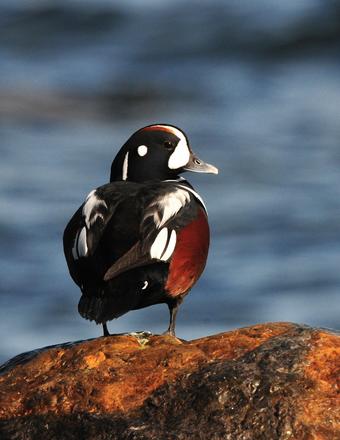
The strait is prime wintering territory for harlequin ducks, and there are several locations on the east coast of Vancouver Island (particularly the area from Qualicum Beach to Quadra Island) that host more than 100 birds; individual birds are known to return to the same section of shoreline year after year. Unlike most other sea ducks, they are found in association with rocky shorelines and substrates, and they prefer to forage close to shore (usually within 15 m). However, they are strong divers and their exceptional buoyancy permits them to feed in the white water where waves crash on the rocks. They prey heavily on marine invertebrates such as crabs, amphipods, and gastropods (snails, limpets and chitons) and small fish. They also aggregate at herring spawning locations in the northern strait. Michael Rodway confirmed that 3,400–5,550 birds (55–87 percent of the strait’s wintering population) gathered at a small number of sites along the same 8-km stretch of shoreline each year that herring spawn was available at that location. While some birds had travelled as much as 150 km to reach the spawning areas, most had come no more than 80 km. Individuals stayed 2–3 weeks, eating only herring eggs, and then returned to their wintering grounds. Harlequins that winter in the strait breed as far away as the Rocky Mountains in Alberta, Montana and Wyoming, and they are unusual because they breed near fast-moving, cold-water streams. They moult in the strait during the winter.
Researchers at Simon Fraser University Centre for Wildlife Ecology have assembled a database on banding, recapture and resighting information that is helpful in tracking harlequin movements and habitats. For example, a female banded as a duckling at Mount Black Prince in Peter Lougheed Provincial Park, Alberta, on August 27, 1998, was re-sighted at Shelter Point, Campbell River, on October 21, 1998, and again on March 21, 1999. A third-year male was banded at Shelter Point on August 19, 1998. This male and female were seen as a pair at Shelter Point on March 25, 2000, while six weeks later on May 13 they were seen as a breeding pair in Glacier Park, Montana. These observations highlight the fact that birds return to the same wintering area in the Strait of Georgia year after year and also indicate that pair formation occurs on these wintering grounds.
From Comox southward on the east coast of Vancouver Island there is a major wintering area for the long-tailed duck; these birds are also common during the winter in Boundary Bay near White Rock, BC. The long-tailed duck is the deepest-diving sea duck, regularly achieving depths of 15 m but also capable of diving as deep as 22 m. It is the most common sea duck to be encountered farther than 5 km from shore. Long-tailed ducks are considered generalist feeders, choosing a wide variety of invertebrates, with molluscs and crustaceans forming the bulk of their diet. They are also reported to eat small fish such as the Pacific sand lance in their wintering areas and to consume herring spawn at stopover sites during spring migration. Long-tailed ducks form small flocks (usually less than 50 birds) except during herring spawning season when thousands come together. During a boat survey near Comox in March 2003 there were so many birds it was only possible to estimate the number as approximately 10,000 birds.
Long-tailed ducks are circumpolar and breed in the Arctic tundra of Alaska, most of northern Canada, Greenland, Iceland, Scandinavia and across Russia. Through-out their range they are harvested for subsistence, including approximately 10,000 harvested annually in Alaska alone. Some moult their flight feathers in groups—which number in the tens of thousands—on large inland thaw lakes and in protected Beaufort Sea lagoons.
Three species of merganser are found in the Strait of Georgia. The common merganser is resident here, while both hooded and red-breasted mergansers are easy to see in the strait during winter, usually near the shore in bays, estuaries and inlets. All of the merganser species are fish-eaters and possess a serrated bill that helps in the capture and handling of prey. They are known to eat small to medium-sized (5–30-cm) fish such as herring, young salmon, sculpins, blennies, sticklebacks and flatfishes. Like other sea ducks, they consume large quantities of herring eggs, while invertebrates such as shrimp are also common prey.
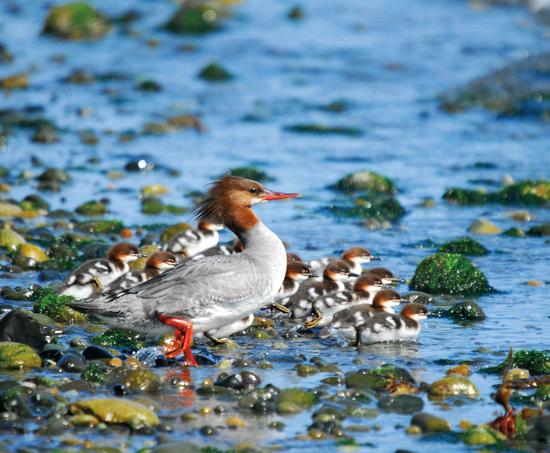
The common merganser can often be seen through the winter in fresh and brackish waters in estuaries and protected bays and inlets. They breed on the marine shores of the strait and on the forested shores of lakes, streams and rivers from southern Alaska across southern Canada. Like the other mergansers and sea ducks, they are attracted to herring spawning sites and in autumn frequent salmon spawning rivers to feed on eggs. In addition, a detailed study conducted on the predation of seaward-migrating salmon, specifically at three streams with hatcheries on eastern Vancouver Island, showed that stream-foraging mergansers ate salmon exclusively. According to the study, from 1980 to 1982 broods of common mergansers consumed an estimated 82,000–131,000 coho salmon fry in the Big Qualicum River between June 10 and August 25. However, those birds foraging in the tidal waters of the estuary rarely ate salmonids, choosing instead small sculpins and flatfishes.
The estuaries and protected bays and inlets of the strait are the centre of wintering distribution for the hooded merganser, which gets its name from the male’s striking head plume or hood. They breed in cavities (including nest boxes) in forested areas from southern Alaska through British Columbia, southwestern Alberta to Oregon and Idaho, usually near fresh water but sometimes near brackish water in the strait. The birds can be observed close to shore, often with fish or shrimp wriggling in their bills; they swallow their prey whole.
The red-breasted merganser shows signs of segregation of sexes during the winter, with males forming sea populations that shift from place to place in search of food, while females and yearlings are generally observed on rivers and estuaries. Reports from the Pacific Biological Station in Departure Bay describe flocks of a hundred or more adult males arriving, descending upon the herring, feeding aggressively for a short period and then leaving almost immediately. These birds dive to force the herring to school, and the resulting “herring balls” attract gulls and ducks, which form dense and competitive packs, both on the water and in the air. The birds that winter in rivers and estuaries will move upriver to feed on the eggs of chum, coho and other salmon, as well as salmon smolts in the lower reaches of streams. Red-breasted mergansers leave the strait by May; their nesting distribution is circumpolar.
The remainder of the diving ducks that winter in the strait includes four species of the genus Aythya (greater and lesser scaup, ring-necked duck and canvasback) and the ruddy duck, which is also referred to as the stiff-tailed duck because of the upward angle of the tail. The most abundant of the group are the scaup and, in particular, the greater scaup, which is widespread in BC during winter. Most of their foraging activity occurs in shallow marine habitats (less than 2 m) with soft substrates; it is the only marine-associated diving duck that will readily consume marine algae and plants as well as animals such as mollusks, crustaceans and herring spawn.
In a study of the Fraser delta intertidal area, greater scaup were among the most numerous diving ducks found there. The highest count was in spring, with the birds becoming scarce in summer then abundant again in fall and winter, a pattern of timing that was consistent throughout the strait. Comparisons of southern Vancouver Island estuaries concluded that the estuaries of the Comox and the Chemainus rivers had higher densities of greater scaup than those of the Nanaimo or Cowichan rivers; this is likely related to the abundance of their preferred prey species of bivalves and snails in the former. During spring migration large concentrations of greater scaup can also build up where herring are spawning. The lesser scaup is less commonly observed in marine waters as it prefers ponds, but both species can be seen flocking together near Stanley Park in Vancouver. The lesser scaup breeds throughout the BC Interior, Alaska and across northern Canada, while the greater scaup breeds throughout the Arctic. Both are hunted and often called “bluebills.”
Ring-necked ducks prefer fresh water where they dive and dabble for aquatic plants, but they are occasionally seen in marshes and coastal bays as well. Unlike other diving ducks, they can spring up directly from the water into flight. They nest all over the northern part of North America, including BC. Canvasbacks and ruddy ducks dive for plant material mostly in shallow water, but they will also eat invertebrates from soft sediments. The delta of the Fraser River is the centre of their wintering area, particularly over the North Bank intertidal areas, and it has been suggested that these species may be attracted to areas where there is eutrophication (such as the Iona Island sewage lagoon). Ruddy ducks are also reported to concentrate in Boundary Bay during winter; however, the annual Christmas bird counts show great variation in winter numbers. Both canvasbacks and ruddy ducks breed in western North America, including the BC Interior.
Raptors
This section focuses on those few species of raptors—birds of prey that include eagles, osprey, falcons and hawks—which breed in the strait or prey on the marine resources or the bird populations affiliated with coastal aquatic ecosystems in this region (marine birds, waterfowl, waterbirds or shorebirds). Those raptor species affiliated more closely with terrestrial prey such as rodents and songbirds are not included here.
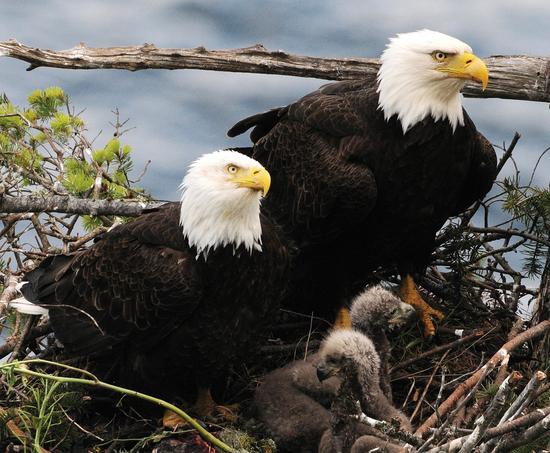
Bald eagles are the most common and highly visible raptor in the region and can be seen year-round. They build large stick nests in trees, breed in the spring and raise up to three young on a diet of gulls, cormorants, fish and carrion. In recent years the Hancock Wildlife Foundation has installed web cams on several nests around the strait, allowing the public to quietly spy on breeding pairs as never before.
In the 1960s groundbreaking toxicological studies of bald eagle eggs revealed that concentrations of organochlorine chemicals (PCBs), dioxins (PCDDs) and furans (PCDFs) were five times higher in eggs taken from nests in the proximity of the pulp mills in the Strait of Georgia than from those in less industrialized areas. This contamination has been reduced since the use of PCBs was banned in Canada in 1970 and regulations requiring pulp mills to reduce production of dioxins and furans were implemented in 1989. Subsequently, bald eagle reproduction increased for several decades. However, a new study using long-term data suggests that population growth has now levelled off in a density-dependent manner.
In the late fall and winter bald eagle numbers swell, and this leads researchers to think that the entire British Columbian and Alaskan population may mingle and move as a large group during later summer, fall and winter. They are omnivorous and opportunistic scavengers and appear to track the spawning of salmon in major coastal rivers, feeding on the carcasses that die after spawning; thousands of bald eagles can be seen along the Squamish and Qualicum rivers and other estuaries where spawning occurs. They have also been reported to prey on eulachon or “candlefish,” which, like salmon, enter fresh water such as the Fraser River to reproduce during fall and winter. In the spring the eagles will form aggregations to prey on other birds drawn by herring spawning events.
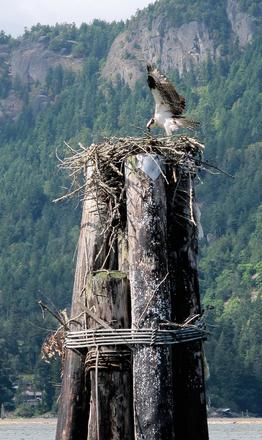
The osprey is another distinctive raptor, slightly smaller than the bald eagle and a specialist on fish. They can be seen in the strait during summer, mostly as migrants, although some nesting activity has been recorded. Osprey forage in rivers, streams, estuaries, bays and lakes; they hover high over the water, then plunge feet first to grasp fish with their specially designed talons. The wriggling fish are carried to a perch or to their large stick nests for consumption. The species is found worldwide but some of the highest concentrations are observed in the Creston and Nelson area of the BC Interior.
Peregrine falcons are uncommon along the strait but can almost always be found on the Fraser River delta from fall through spring. They prey exclusively on birds and will track migrants and winter visitors, with ducks and shorebirds favoured. They kill their prey in mid-air by diving at record speeds with wings tucked to minimize drag. Behavioural research conducted through the Centre for Wildlife Ecology at SFU shows that peregrines kill most shorebirds when high tides cover the mud flats. At Boundary Bay large flocks of shorebird prey, such as western sandpipers, work to avoid predation by falcons; like schools of fish, they rely on safety in numbers and the synchronization of evasive movements and constant vigilance. Some peregrine races are highly migratory and northern populations spend winters in southern locations.
The merlin deserves mention here as well because it is a major predator, particularly in the Fraser River delta, of migratory shorebirds such as dunlin and western sandpiper. Similar to tiny peregrine falcons, they are most common in the strait during spring and fall migration as they transit between their northern breeding areas in the woods of Alaska and Canada and wintering areas as far south as Peru.
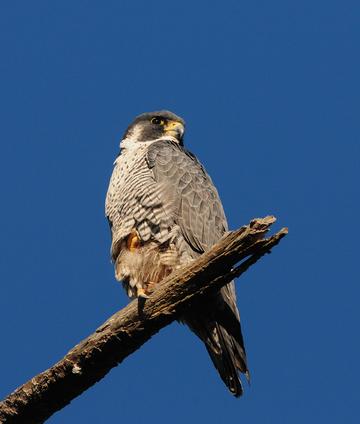
Shorebirds
Shorebirds in the Strait of Georgia range in size from 19 to 300 g. Most are highly migratory, and the Fraser River delta is an internationally important stopover site for several million of them each spring and fall. They often form flocks of thousands of birds, and it is amazing to see an enormous flock of western sandpipers in fl ight, moving as one, alert for falcon predators as they select their next feeding or resting spot. Many of these shorebirds depend on sand and mud-flat habitats for food, and most species have long bills for probing the sediments to capture very small prey, including crustaceans and worms.
Of all of the shorebirds in the region, the western sandpiper is the most studied and a good representative for the group. It is a common bird in the western hemi-sphere and a great example of a long-distance, neotropical (south of the Tropic of Cancer) migrant. Multinational studies have used it as a model species because it spends the winter months in Central and South America but breeds in Alaska (fig. 5). Researchers have tracked single bird migrations by banding individuals, each with a unique number, and attempting to recapture them at known stopover or destination sites. Researcher Pat O’Hara banded a fledgling bird at the breeding site in Nome, Alaska, in June 1994 and recaptured the same bird later that year at Playa El Reten in Panama; it’s likely that this bird settled down in the Georgia Basin on its flight south. Advances in radio telemetry have also allowed researchers to fit individual birds with tiny radio transmitters, making it possible to follow them without recapturing them. As a result, there is now positive evidence that birds that winter in Mexico, Panama and San Francisco Bay all stop over at Roberts Bank near the Tsawwassen ferry terminal on their way to the Copper River delta in Alaska.
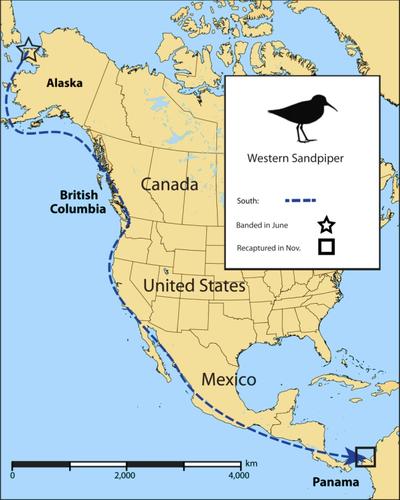
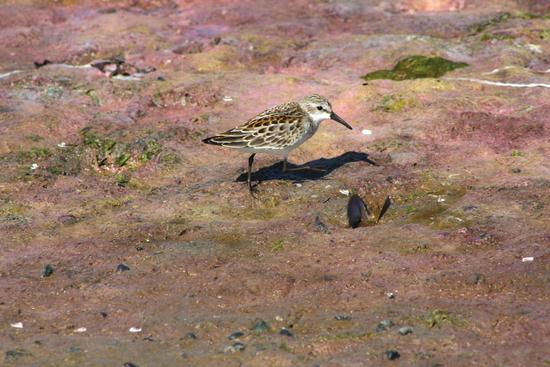
Sandpipers can eat seven times their body mass per day while on migration, and they have an amazing variety of bill shapes to capture a wide variety of prey. Fortunately, the extensive range of habitats available throughout the strait supports the necessary variety of prey sought. Recent research revealed that, in addition to probing for amphipods and other invertebrates, western sandpipers also graze the biofilm on the surface of the sand and mud flats in the intertidal zone. Feeding on biofilm (sometimes called “snot feeding”) can account for 45–59 percent of their total diet, or 50 percent of their daily energy intake. The Canadian Wildlife Service has estimated that the 6,000 hectares of intertidal mud flat of Roberts Bank hosts more than a million western sandpipers over approximately a 15-day period during their northward migration to the breeding grounds in Alaska. Calculations based on each sandpiper ingesting 190 g of biofilm per day (approximately seven times mean body mass) suggest that 19,000 kg would be consumed per day by an average flock of 100,000 sandpipers.
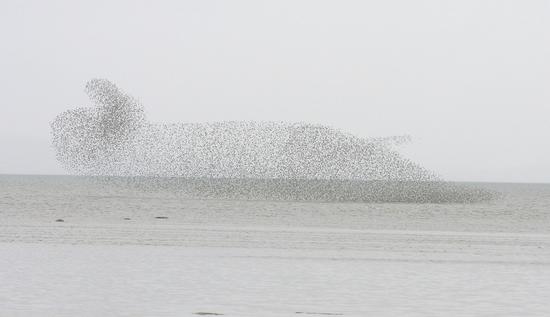
Between mid-April and mid-May, Moira Lemon of the Canadian Wildlife Service has surveyed the annual northward migration of western sandpipers from the dike road along a 2.5-km stretch of foreshore from the Roberts Bank coal port causeway to Brunswick Point at Canoe Pass on the Fraser River, where the highest densities of migrating shorebirds can be observed. Her daily surveys were carried out as close as possible to the 11.3-foot tidal height, when approximately 500 m of the mud flat was exposed so that all the birds were within visible range from the dike. Her research shows that a large population of dunlin overwinter throughout the Fraser River delta and the Boundary Bay area, and these birds mix with the western sandpipers during their spring migration. Figure 6 shows the survey results from 2008. On April 9 there were an estimated 42,000 dunlin there that had spent the winter in the region. Their numbers then rose as birds from the south moved into the area, peaking at 82,000 in mid-April, after which they declined as the birds moved north. As the dunlin numbers declined, western sandpiper numbers increased, peaking around the end of April at 140,000 birds, and then declining rapidly until mid-May when most of the birds had migrated north. These survey data focused on a small area, but they clearly demonstrate the timing of migration and the very large numbers of birds that depend on the extensive mud flats and marshes of the Fraser River delta.
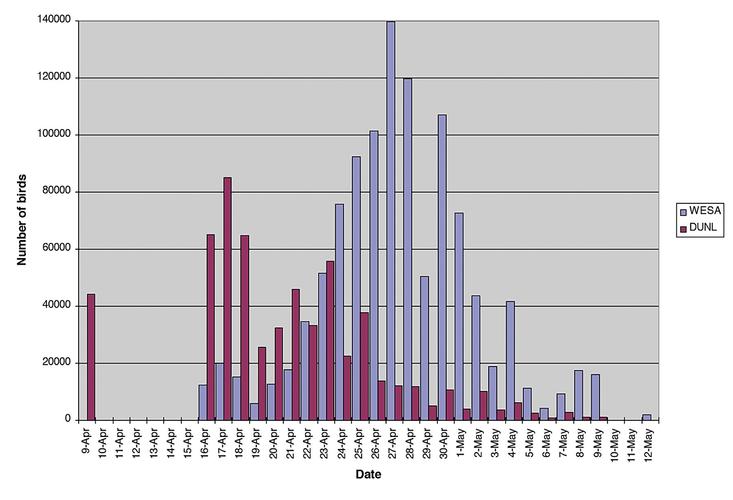
Sanderlings and the tiny least sandpiper—sometimes called “peeps” by birders—are migratory birds that also use the sand and mud flats. The peeps are often joined by plovers, including the semi-palmated plover, killdeer and the much larger black-bellied plover, all of which pursue gastropods, bivalves and marine worms. These birds also frequent adjacent cultivated fields in Delta, particularly in winter, to eat terrestrial insects and worms. Black-bellied plovers can be seen year-round in Boundary Bay. Large whimbrels and stocky short-billed dowitchers will also be found on the mud flats. In the marshes of the Fraser River estuary, long-billed dowitchers probe for marine worms while greater and lesser yellowlegs may hunt for small fishes. Regional shorebird expert and naturalist Rob Butler notes that no month goes by when migratory shorebirds are not to be found on the Fraser River delta.
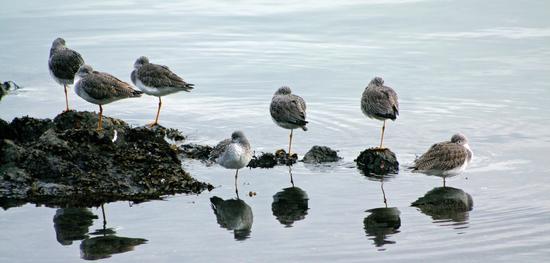
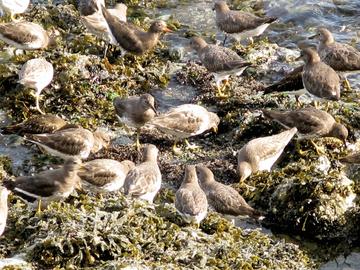
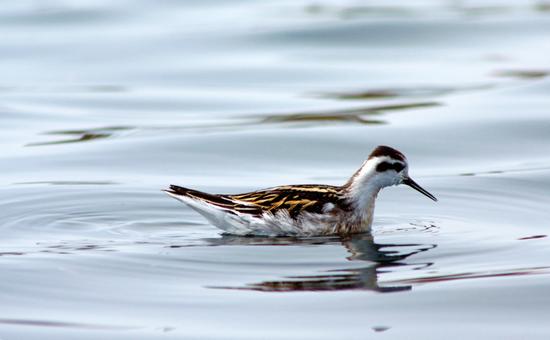
Other migratory shorebirds also prefer the strait’s marine habitats. Kayakers might see wandering tattlers feeding alone on mollusks, crabs and amphipods in wavewashed rocky areas. Surfbirds are commonly seen on rocky marine islets, using their short bills to forage on mussels and barnacles, with special attention given to any herring spawn stuck to seaweed. They often migrate with black turnstones, and recently both were documented using the rocky islets off Saturna and Mayne islands in Gulf Islands National Park. The black oystercatcher (picturesquely called the “carrot bird”), one of the largest shorebirds, is easily distinguished by its long orange bill. These birds don’t eat oysters but use their bills to pry limpets and mussels from the rocky intertidal zone. They are residents of the strait and breed on small rocky islets with rich intertidal areas where they are protected from mammal predators and other disturbances. Finally, there is the unusual red-necked phalarope, which naturalists call the “sea-sandpiper” because it lands on water and feeds on marine invertebrates. Prey is drawn to the phalarope as it uses its webbed feet to spin while swimming in circles. Phalaropes can be seen in the fall on the open marine waters of the strait, but they breed in the Arctic and migrate south to winter on tropical oceans.
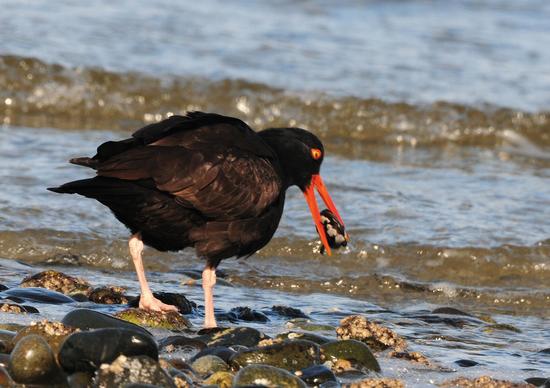
[To Top]
Gulls, Terns and Jaegers
A wide variety of gulls and terns use the Strait of Georgia region year-round, like the large glaucous-winged gull; some are part-time visitors during the late summer, like the Heermann’s gull; and others appear during fall and spring migration, like the tiny Bonaparte’s gull. All of the gulls and terns are excellent flyers and gliders, but they cannot propel themselves underwater with either feet or wings. Both gulls and terns will feed while flying or floating on the water, often upending to reach more deeply under the surface and occasionally making plunging dives into the water from the air. Large feeding groups of gulls can form when fish or zooplankton prey concentrate near the surface. Gulls and terns also walk well, so they feed on many things in the intertidal areas of bays, estuaries and, after heavy winter rains, soccer fields.
Glaucous-winged gulls are resident year-round as they breed in colonies on small islets in the strait. They often fly near a moving ferry and frequently nest on pilings or other nearby structures. Omnivorous and very opportunistic birds, they adjust quickly to changes in their environment. In the marine ecosystems they will eat fish (herring, sand lance and salmon smolts), fish eggs (herring and salmon), crustaceans (euphausiids and crabs), mollusks (clams and mussels) and echinoderms such as sea stars. On land, they will eat worms, insects, grubs and carrion (salmon carcasses) as well as garbage when it is available. Human refuse was found in 70 percent of adult gulls sampled during the 1980 breeding season.
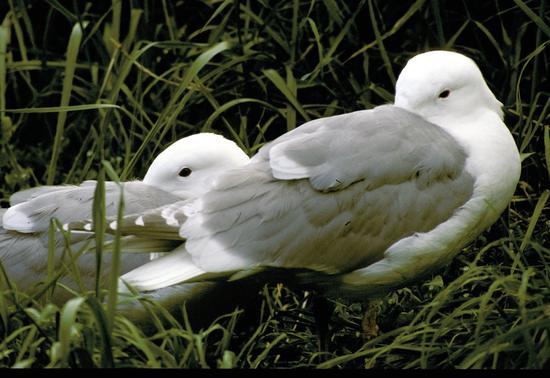
Some classic work on marine bird reproduction has been undertaken on Strait of Georgia gulls. In 1964, Kees Vermeer of the Canadian Wildlife Service showed that gulls could raise more eggs than they usually lay, and he argued that if sufficient food was available, gulls could increase the number of young produced in a year. This may explain the considerable changes in the gull populations in the strait. From 1960 to 1986 they doubled their nesting populations to 13,000 pairs. In the largest gull colonies on Mandarte Island in Haro Strait the numbers rose from historical values of 500 pairs in 1915 to 2,200 pairs in 1986, and on Mitlenatch Island near Campbell River from 250 pairs in 1922 to 2,100 pairs in 1986. Subsequent to 1985, gull numbers declined substantially—up to 75 percent on Mandarte Island, according to graduate research by Louise Blight at UBC. Research has also shown that birds from colonies outside of the strait will migrate to the region in the fall and winter. Such was the case with a juvenile glaucous-winged gull that was banded in August 2007 on BC’s largest and most remote seabird colony, Triangle Island (off the northwest tip of Vancouver Island), and was re-sighted in Comox on September 28 of the same year.
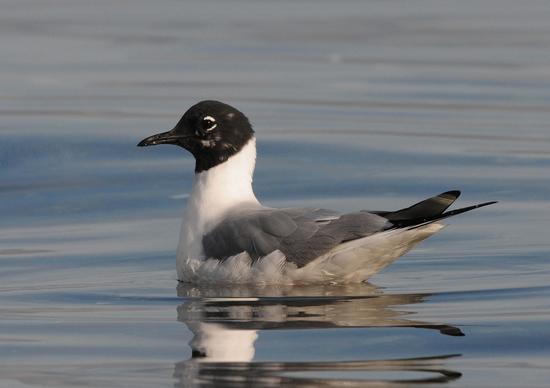
The Bonaparte’s gull is present in large numbers during migration, particularly in the spring, but it also winters in the strait and shows migratory activity throughout the summer. It breeds near bogs or lakes in boreal forests across western Canada and Alaska and nests in conifer trees or sometimes on the ground, either in pairs or in small colonies. Compared to other gulls, it is small and very graceful and acrobatic in flight and can forage while flying. During fall and spring thousands of birds can be seen on and off the water in Active Pass, feeding on the planktonic crustaceans brought to the surface by the process of upwelling; in the fall this is mainly amphipods, while in the spring their prey is mainly euphausiids, but they also take fish, fish eggs and intertidal organisms. In the spring thousands of Bonaparte’s gulls join other shorebirds at herring spawning sites to feast on eggs, and they are among the most abundant gull species attracted to summer hatchery releases of chum, coho and Chinook salmon smolts. Unlike most other gulls, the little Bonaparte’s gull rarely scavenges.
Mew gulls are abundant spring and autumn migrants, and the strait is also an important wintering area for them. Large numbers join the Bonaparte’s gulls in Active Pass during February and March, attracted by the concentrated euphausiid prey in surface waters. They feed on zooplankton along tidelines and oceanfronts as well as on fishes and intertidal organisms, and they congregate at abundant food sources such as herring and salmon spawning areas. Mew gulls breed from central and southern Alaska to northwestern Canada and are found along the BC mainland coast and at inland lakes throughout Vancouver Island.
California gulls migrate through the strait, and in autumn they can be one of the most abundant gulls in coastal areas. They gather at river mouths to eat fish and carrion and visit plowed agricultural fields for worms and rodents. They will also feed on refuse, and early observations of banded birds at Vancouver’s garbage dumps reveal birds from colonies in Saskatchewan, Alberta, North Dakota, Montana, Wyoming, California, Oregon and Washington. The only BC colony of California gulls can be found among the ring-billed gulls on Lake Okanagan. While ring-billed gulls are resident in the Strait of Georgia, like California gulls, they breed on islands on inland lakes in western Canada and have only been found on Lake Okanagan since 1968. The BC numbers increased between 1960 and 1990, and this is thought to reflect human population growth and the associated availability of garbage. The ring-billed gull is omnivorous and will eat fish and invertebrates on the coast, frequent plowed fields for worms and take refuse and scrap in cities. They are often seen with other gull species from which they will steal food. They avoid the open ocean.
The Thayer’s gull is a common visitor from mid-fall through to mid-spring. This is the only gull that breeds exclusively in Canada, choosing remote Arctic islands as far east as Baffin Island. A local photographer has confirmed that a banded Thayer’s gull observed near Courtenay on Vancouver Island was banded on St. Helena Island, Nunavut, in 2003 (fig. 7). The largest concentrations of Thayer’s are to be seen with other gulls during herring spawning, but they are omnivorous and use a variety of marine and terrestrial habitats.
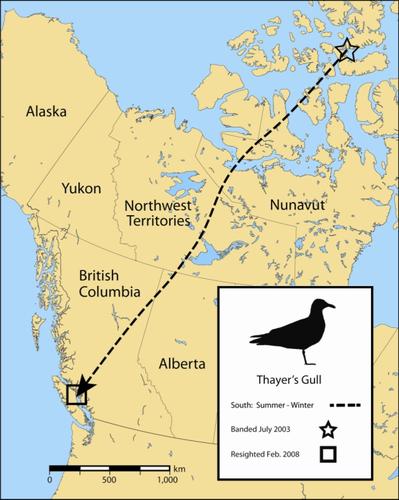
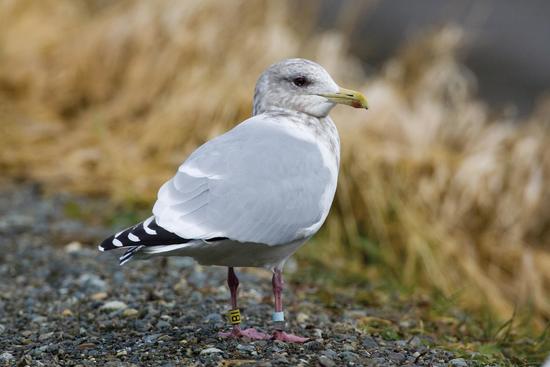
A beautiful summer visitor to the Strait of Georgia is the Heermann’s gull, which prefers marine shores and avoids fresh water. These birds can forage for small fi sh and invertebrates while in flight, but they will also pick at the surface and make shallow dives. They have a very restricted breeding range with 90 percent of the population gathering on one island in the Gulf of California. Their restricted range contributes to their listing as “near threatened” by BirdLife International.
Herring gulls are uncommon fall and spring migrants, with few spending the winter. They often roost with large gulls like the glaucous-winged gull and are also found feeding along marine shorelines as well as in terrestrial habitats. They nest on inland lakes and are more widespread in the interior of BC and across the northern hemisphere than in the strait.
Caspian terns are mostly seen in late spring/early summer on Roberts Bank in the Fraser River estuary. These birds, the largest of the terns, are found worldwide, but their numbers are expanding in the Pacific Northwest with a huge population growth in the Columbia River estuary. That colony has expanded by 600 percent since 1986 due to islands that have been created from dredged river materials; it is now the largest colony north of Mexico. In recent years, small colonies have also formed in Padilla Bay in Washington State, while ongoing nesting attempts at Roberts Bank suggest they could become established there as breeders in the near future. Caspian terns forage over water and pick fish near the surface, but they are acrobatic flyers and plunge dive for deeper fish. The common tern is frequently seen during summer and fall in the strait, but most of these birds are believed to be travelling from breeding lakes on the prairies to wintering grounds in the oceans off South America; as a group, the terns undertake some of the world’s longest migrations.
The parasitic jaeger is a migrant that uses the strait as a stopover in the fall on its way from breeding grounds in the Arctic tundra to wintering areas on subtropical seas. It is a gull-like seabird that will aggressively pursue Bonaparte’s gulls, mew gulls and common terns in an attempt to steal their fish prey in mid-air.
Alcids
The birds of the family Alcidae, or alcids, are true seabirds, only coming onto land to breed. They dive underwater, propelled by their wings, to capture fish and invertebrate prey. Most alcids nest in colonies on islands that are free from mammal predators.
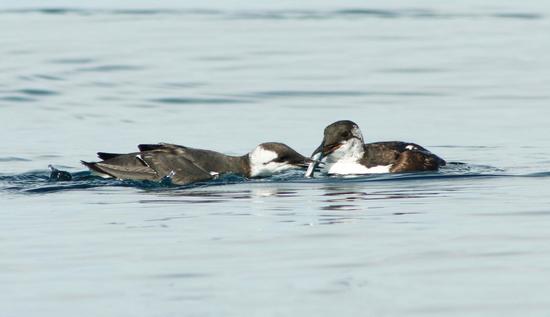
There are no colonies of the common murre, a large seabird (900 g), in the Strait of Georgia, but many thousands of birds from colonies in Washington, Oregon and California spend the fall and winter here and in neighbouring Juan de Fuca Strait. However, there is a small colony of roughly 4,300 (in 2004) common murres on Triangle Island off Cape Scott at the north end of Vancouver Island, and it is very likely that some of those birds also spend time in the strait in late summer, fall and winter. Adult males feed the young after fledging in the late summer and can be seen together, as in the photo of a father feeding a sand lance to its growing chick. Murres can dive to great depths (90 m) in search of fish and invertebrate prey, and a study of common murre diet that was undertaken in Puget Sound in the late summer and early fall indicates that they eat mostly herring, followed by sand lance, salmon and threespine sticklebacks. They prey on fish from below and are often involved in forcing the formation of herring balls, tight schools of fish at the surface, which can be detected by the frenzied feeding activity of gulls and other conspicuous birds.
On January 1, 2012, Guy Monty, a Vancouver Island naturalist volunteer, doc-mented a once-in-a-lifetime aggregation of common murres.
This afternoon we witnessed the most amazing numbers of common murres I have ever seen. Numbers at the Little Qualicum easily surpassed the entire breeding population for BC several times over. Massive, massive, massive numbers of murres were in a dense flock covering well over a square kilometre from the Little Qualicum estuary back towards Qualicum Beach, and although the density changed as one went east and west of there, huge numbers of birds were present for kilometres both ways. If you have witnessed the scoter flocks here in the spring, this was way, way beyond that. Truly the largest gathering of any species of sea bird I have ever witnessed in British Columbia. I made no attempt to count them, but the numbers at the Little Qualicum alone easily exceeded 100,000 birds. Mixed in were many thousands of Pacific loons and long-tailed ducks, and lesser numbers of ancient and marbled murrelets and perhaps 25,000 gulls.
As they dive so deeply in search of prey, common murres are the bird most frequently caught in late summer and fall gillnets in the strait. (See “Threats,” page 245.) Biologists are attempting to measure the impact of murre mortality from gillnet fishing while at the same time trying to reduce the frequency of net entanglements. However, one reason the common murre may be so sensitive to this injury is that this species is the most reluctant to move away from approaching boat traffic.
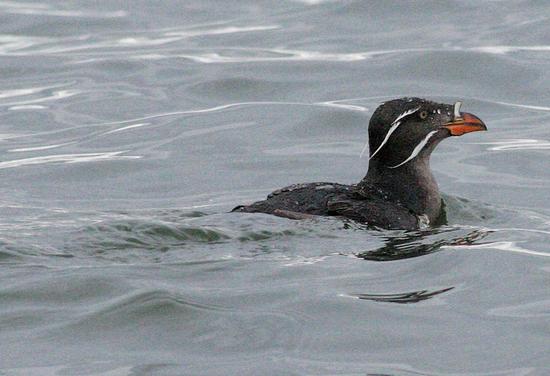
The rhinoceros auklet is a moderate-sized (500 g) member of the Alcid family. Its name comes from the conspicuous “horn” on its bill during breeding season. British Columbia has roughly half of the world’s population of this species, although there are no large colonies in the strait; a few breeding pairs make use of Mitlenatch and Mandarte islands. Colonies do exist on nearby Smith and Protection islands on the American side of the Strait of Juan de Fuca, but these birds are scarce as they generally winter off the outer coast of California. Like all alcids, they have very fast wing beats and often fly close to the water. They are known to fly long distances when foraging, so it’s common that breeding birds may be observed in the strait in summer. The females lay a single egg in an underground burrow, and both parents feed the chick at night on a diet of fish. The adults capture their prey by diving and carry the fish crosswise in their bills, adding fish to their “bill load” sequentially; they can manage up to twenty small fish or a single large fish at a time. Parent birds with a load of fish in their bills can be observed on the water, waiting for darkness before they return to the colony. The chick leaves the burrow in 45 to 60 days to begin life at sea on its own. Rhinoceros auklets forage in close association with common murres and eat similar prey, primarily herring, followed by sand lance and salmonids. A larger, more glamorous relative of the rhinoceros auklet, the tufted puffin, used to breed in small numbers on Mandarte Island but no breeding colony remains. Washington State is considering listing the species as “endangered.”

The pigeon guillemot is a conspicuous, moderate-sized alcid (400 g); the adult breeding birds are primarily black with white wing strips, and the inside of the bill and feet are an amazing orange colour. These birds nest in small colonies in the rocky crevices of small islands throughout the Strait of Georgia, notably on Mitlenatch Island, though they may occasionally use man-made structures such as ferry terminals for nesting. While most alcids lay a single egg each breeding season, the pigeon guillemot lays two eggs and, when conditions are favourable, can raise both chicks. Most of their prey are bottom-dwelling (benthic) fish such as blennies, pricklebacks, gunnels and sculpins, which are often captured close to the colony as food for the nestlings. The parents make multiple trips each day to feed the young and have a habit of sitting on a nearby rock waiting for the safest time to enter the nesting crevice with their prey. However, on Mitlenatch Island, young guillemots may become the prey of large resident garter snakes, which can slip into tight nesting spaces in the rocks. During the non-breeding season the birds moult their feathers and adopt a salt-and-pepper plumage, a mixture of black and white that can make identification very tricky. Guillemots often sit in groups on rocks and make their funny “weeeeeeeeee” call.
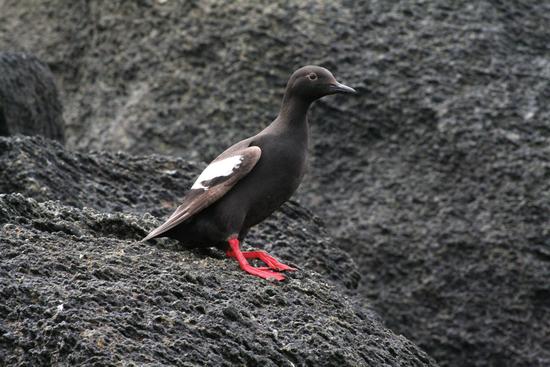
Ancient murrelets are small (200 g) colonial nesting seabirds, and half of the world’s population breeds in Haida Gwaii and nests in underground burrows. In Canada they are listed as Special Concern under the Species at Risk Act because of threats from the introduction of rats and raccoons to major colonies on the small islands where they nest. The removal of rats from Langara Island may allow the colony there to recover, and this may also permit peregrine falcon populations to recover as well since they prey heavily on these seabirds. Ancient murrelets migrate south in fall and winter, feeding on zooplankton and small fishes. On December 17, 2011, citizen scientist volunteers on the Roberts Creek pier who were taking part in the annual Christmas Bird Count program run by the National Audubon Society observed more than 21,000 ancient murrelets flying south down the strait in a period of just 75 minutes. It set a North American record for the species. These large numbers also highlight the importance of the strait for migratory seabirds.
Another small alcid resident in the strait is the marbled murrelet, which is known to fly at speeds of up to 110 km/h. But while seabirds typically breed in colonies on off-shore islands, this species nests solitarily in old-growth forests up to 50 km from marine shores. The female selects a tree with broad moss-covered limbs and lays a single egg directly in the moss without building a nest. The parents take turns incubating the egg, exchanging duties in the early morning. The secretive nature of their nesting habits and early morning activities are thought to reduce exposure to predators. Once the chick hatches, the parents make early morning feeding visits carrying a single fish held cross-wise in the bill; the chick is fed for 30–40 days then leaves the nest to fly to the ocean and begin feeding itself.
The bird’s use of the marine environment in Toba Inlet and Desolation Sound for feeding indicates general associations with areas with higher tidal speeds, greater water depth, steeper ocean floor slope, less freshwater inflow and proximity to sandy beaches. This suggests a close linkage to the location of its favoured fish prey species, the Pacific sand lance. The locations of breeding birds on the ocean are also associated with the distance to their inland nest locations, and research indicates that conservation efforts for marbled murrelets need to consider the availability of suitable nesting habitat within proximity of good marine foraging areas as both habitats are required for their successful reproduction and long-term survival.
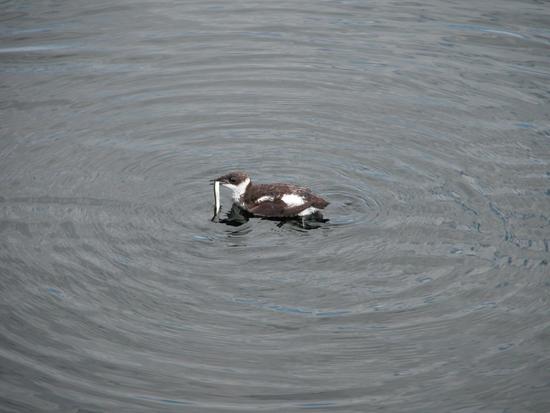
The marbled murrelet is listed as Threatened in both Canada and the US due to loss of its nesting habitat in old-growth forest, but because of the bird’s secretive nature, the first active nesting spot in BC was not confirmed until 1993. Despite this bird being very difficult to study, much research and monitoring effort has been directed toward the species, and new techniques have been employed to gain insights into their marine and terrestrial habitats. By capturing birds on the water at night and fitting them with small radio transmitters, then using a helicopter and receivers designed to detect the unique signals for each bird, researchers from the Centre for Wildlife Ecology at SFU have been able to track individuals to their inland nesting locations. In Desolation Sound nests were located from 12 to 102 km from locations on the water at elevations from 300 to 1,300 m. The nests were often located in “distinctive” trees, taller and with more potential nesting platforms than others nearby. Research has also shown that marbled murrelets that breed in the strait stay in nearby waters and may remain in the strait year-round. Adult birds captured in the summer in Desolation Sound were observed the following winter at the same location. Another bird, banded in Desolation Sound in the summer, was found that winter in the San Juan Islands, while a juvenile that was fitted with a radio in Desolation Sound remained there or nearby on the east coast of Vancouver Island for months.
Other Birds Affiliated with the Strait
This section is a catch-all of other notable species associated with the Strait of Georgia ecosystem. Snowy owls usually winter in the north, but in years when food is scarce they will move south to the Fraser River delta and Boundary Bay; here they form groups to prey on waterfowl. Such a group formed in December 2011 and striking photos of these large white owls made the front pages of the newspapers and attracted many viewers.
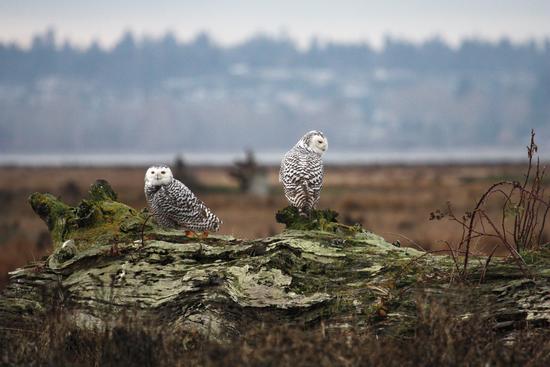

Belted kingfishers are distinctive common residents and winter visitors to the region. They are found near still waters where fish prey such as stickleback, juvenile herring and sand lance can be seen from the air. They perch over water or hover and plunge dive when vulnerable prey are detected, entering the water head first, catching fish prey in their bills, surfacing and taking flight immediately. On return to their perches, they subdue and consume their prey. Their nestlings are fed in burrows dug by the parents into the side of a bank near feeding areas. Belted kingfishers nest throughout the continent but leave their most northerly nesting sites to winter in southern regions.
The northwestern crow, another common resident in the strait, breed in seabird colonies such as Mitlenatch Island. These birds will eat almost anything, but in the marine ecosystem they are most commonly seen foraging in intertidal areas. They are highly intelligent and watch for any fish or invertebrate prey that might have been dropped; they also steal unattended eggs from gulls and cormorants. They are gregarious, and after the breeding season will form large night roosts. A larger relative of the crow, the common raven, is also a resident in the region. They are omnivorous and successful scavengers of carcasses, including spawned salmon. Both ravens and crows prey on the eggs and nestlings of marbled murrelets; presumably these predation pressures are part of the reason that the marbled murrelets nest far from the sea.
The purple martin is a large swallow that winters in the tropics and breeds as far north as the Strait of Georgia, particularly around Ladysmith and the Nanaimo River estuary. They are included in this group of “other birds” because they forage for insects over marine waters and nest along the coast in small colonies. By 1980 the number of purple martins in the region had severely declined due to loss of nesting habitat, but a grassroots recovery operation began building and mounting nest boxes on pilings at marinas. This highly successful program began around Ladysmith, and now over a thousand nest boxes have been installed at seventy marine locations throughout the Georgia Basin, thanks to the British Columbia Purple Martin Stewardship and Recovery Program.
Bird Population Trends
The study of wildlife demography combines the estimation of numbers of birds, measurement, population trends and identification of the instruments of change. The migratory nature of bird populations reflects movements between breeding, moulting and wintering locations. Estimates of changes in populations require accurate surveys repeated over many years and locations, and since bird numbers may fluctuate considerably from year to year, more robust trend results are gained by the study of the longest time series over the largest spatial scales. Population trends have been charted for wintering birds, spring migrants and summer breeders.
Winter Bird Counts
Bird use of habitats in the strait is heavy during winter months, and several surveys, including the Audubon Christmas Bird Counts, have been used to estimate their numbers. A recent study from John Bower at Western Washington University examined several types of winter surveys, involving counts from shore, ferry and plane, to compare historical numbers from the 1970s with more recent numbers collected in the same manner. The comparisons of changes in 37 species are summarized in table 3 on p. 256, which shows the historical differences for two types of survey method. The Christmas Bird Count comparisons strongly reflect bird numbers throughout the area while the other method focuses on changes over time in the southern part of the strait. The comparisons reveal statistically significant declines for many (7–15 of 37) waterbird species as well as increases for 3–6 species. The western grebe, scaup (mostly greater scaup), marbled murrelet and common murre showed declines in all of the comparisons performed. As a graduate student at University of Wyoming, Eric Anderson and his American colleagues conducted a detailed study of the wintering birds of Padilla Bay in the southernmost part of the strait, comparing the results with surveys conducted in 1978–1979 and 2003–2006. This fine-scale study reflected similar changes affecting the broader scale studies with declines in 13 species, including western grebes and scaup, along with increases in 6 of 27 species monitored. The SeaDoc Society is currently working to further refine and update winter population trend estimates for birds of the whole Salish Sea region. Ignacio Vilchis and collaborators have recently reported that species most at risk of experiencing declines are pursuit divers, which specialize on forage fish as prey, such as western grebes and common murres.
Annual winter counts of snow geese by Sean Boyd of Environment Canada indicate a doubling of the number overwintering on the Fraser River delta and estuary, from 30,000–40,000 in the late 1980s to between 60,000 and 70,000 in the late 2000s. Annual mid-winter counts of brant geese by Andre Breault and Sean Boyd of Environment Canada also show an increase on the Fraser delta, from roughly 150 birds in 1990 to 1,050 in 2004. Mid-winter aerial surveys of trumpeter swans show numbers have increased from 947 in 1970 to 6,775 in 2001.
Historical Christmas Bird Counts and raptor counts for bald eagles on the south coast of British Columbia have recently been synthesized by Kyle Elliot and colleagues from Environment Canada and Simon Fraser University. Wintering bald eagle populations increased in BC from 28,400 (1987–1988) to stabilize at an average of 56,000 ± 8,000 (2000–2009). Seventy-five percent of this province’s wintering population resides on the south coast during December and January, mostly along the Strait of Georgia, making it the largest concentration of bald eagles in the world. Despite the overall increase, their winter numbers are generally higher in cool years and are affected by the size and timing of local chum salmon runs. Therefore, eagle counts can fluctuate substantially from year to year as the birds track toward streams and rivers with the largest salmon runs. Long-term peregrine falcon and merlin winter counts from the Reifel Bird Sanctuary on the Fraser River estuary show increases for both species since the 1980s (2–3 percent per year, 1985–2001).
More frequently today, citizen science is being used to augment observations of bird populations in the wild. The Christmas Bird Count is an established program using volunteers to estimate numbers of birds and to adjust for variable survey effort in space and time. Bird Studies Canada organizes volunteers to conduct the British Columbia Coastal Waterbird Surveys and has a network of volunteer birders connected on the internet. One of these volunteers, local naturalist Guy Monty, was the man who reported the record 100,000 common murres near Qualicum on January 1, 2012. The huge number of these birds gathering in the strait was an important observation, particularly since their numbers have declined significantly in historical comparisons of winter surveys. It demonstrates how migratory winter numbers can fluctuate widely and highlights the importance of marine foraging habitats within the strait. The large number of murres in 2012 is likely a response to large abundances of Pacific herring on the east coast of Vancouver Island prior to spring spawning. Impacts on bird populations of changes in forage prey populations are referred to as “bottom up effects” and are discussed in more detail later in this chapter.
Spring Migration Counts and Observations
From 1992 to 2011 the Canadian Wildlife Service conducted annual spring surveys during the northern migration of western sandpiper and dunlin. Rigorous analyses by Mark Drever, controlled for variation in sampling effort, showed no trends in the number of migrating western sandpipers, although dunlin declined until 2001 and then increased to historical levels over the 19-year period of the survey series.
The Brant Festival in Parksville is a community event that attracts many birders and citizen scientists to the beaches of the east coast of Vancouver Island to witness the spring migration of brant. This festival is part of the International Brant Monitoring Project, which has helped to track the birds’ movements and determine black-bellied brant migration pathways and wintering areas. Nestling birds banded on the summer breeding grounds of the High Arctic move to massive Izembek Lagoon on the Alaska Peninsula in the fall, then south to wintering grounds from British Columbia to coastal Mexico. The following spring they move northward along the Pacific coast, and the unique habitats near Parksville attract thousands of migrants.
Summer Breeding Bird Counts
The number of bald eagle nesting territories in the Strait of Georgia has increased to around 2,000 or roughly 4,000 breeding adults; according to the recent synthesis by Elliot and collaborators, the birds’ nesting productivity also increased from 1985 to 2010. Based on Canadian Wildlife Service counts, between 1960 and 1986 glaucous-winged gull populations doubled their nesting populations to 13,000 pairs. On Mandarte Island numbers rose from historical values of 500 pairs in 1915 to 2,200 pairs in 1986, and on Mitlenatch Island from 250 pairs in 1922 to 2,100 pairs. However, based upon doctoral research by Louise Blight with Peter Arcese at UBC, the gull counts in 2010 showed a decline of over 50 percent to 5,600 nesting pairs in the strait and as much as 75 percent on Mandarte Island.
The Canadian Marbled Murrelet Recovery Team has divided British Columbia into six conservation regions, two of which include portions of the Strait of Georgia. In 2002 the Southern Mainland Coast Region had an estimated 6,000–7,000 birds, while the East Vancouver Island Region had 1,000–2,000 birds. A long-term monitoring program to detect population trends in each of these conservation regions is being conducted by repeated sampling using marine radar at key locations. In the early hours prior to sunrise, the numbers are monitored as the birds fly past the radar station, either entering or exiting the forested watersheds where their nesting habitats are located. These monitoring stations are accessible by vessel on the southern mainland coast and by vehicle on the east coast of Vancouver Island. Results have detected significant declines in both the Southern Mainland Coast Region (2000–2009) and the East Vancouver Island Region (2003–2013).
A recent survey by Parks Canada and partners recorded 210 pairs of oystercatchers in the Strait of Georgia, including many in Gulf Islands National Park (see section on conservation and protection at p. 249). The population appears to be stable at present and most of the nesting habitat is on protected lands. There are 20 or 30 great blue heron colonies around the strait, but most birds are concentrated in a few large colonies near urban areas such as in Stanley Park and Point Roberts. Unfortunately, heron colonies may be abandoned after disturbances. Since the 1960s the population has declined about 3–5 percent per year to less than 2,000 birds in the year 2000, and now the great blue heron is listed under the Species at Risk Act as a species of Special Concern. In 2007 Bird Studies Canada and partners began a Breeding Bird Atlas for BC that will help to track the fate and movement of heron colonies as well as other species by using citizen science. The belted kingfisher, northwestern crow and common raven all nest in the strait, but there is limited information on present population numbers and trends. The Breeding Bird Atlas will help to provide such information. A nest box recovery program for the purple martin, which was started in 1986, has grown substantially and 50 sites showed nesting activity in 2011. The population has grown from 150 pairs in 1998 to 585 pairs, which produced a record of 2,200 fledglings in 2011.
[To Top]
Identifying the Causes of Population Changes
The interwoven nature of species’ life cycles and the interactions of their breeding, wintering and migrating environments make it a great challenge to identify and quantitatively attribute the specific causes of population changes. In the natural world, birds are subject to “top down” control from predators and “bottom up” control from food webs within the prey base. In addition, natural events such as El Niño/La Niña, or threats from human activities, affect bird survival and reproduction. However, research and detailed population studies of the ecosystems have been used to gain insights into many of the factors that influence populations of birds that spend all, or at least part, of their annual life cycle in the Strait of Georgia.
“Top down” predator impacts and changes
A recent study of the growing population of bald eagles wintering in the strait highlights the increase of predator populations in recent decades, together with the accompanying “top down” effects on current bird populations. After many years of historical declines, eagle populations have gradually increased, largely in response to the banning of DDT, which through bioaccumulation in the food chain caused hatching failure. Currently over 40,000 bald eagles winter in the strait, and reproduction has continued strong in recent years. This regional population increase is a significant natural threat to many other species and must be considered in analyses that seek to identify causes of variation in bird populations. This includes the decline of great blue heron numbers between 1960 and 2000, which has been linked to the consequences of delayed and/or failed breeding due to the increased frequency of bald eagle attacks on heron colonies as well as disturbance by humans and impacts of toxins.
Based on data from Canadian Wildlife Service counts, glaucous-winged gulls doubled their nesting populations in the strait to 13,000 pairs between 1960 and 1986, but subsequent to 1986 their numbers declined substantially, down by 75 percent on Mandarte Island. It is possible that these declines may also be related to the increased predator populations of bald eagles. However, other factors that influence gull populations were the focus of research at UBC; these include changes in the prey base, historical changes to regional garbage management and the banning of egg collecting.
Between 1985 and 2001 peregrine falcons have increased their numbers by 2–3 percent per year in the strait, increasing the need for vigilance by western sandpipers and dunlin. Sandpipers must balance the risks of predation from peregrines against the benefits of feeding opportunities provided by the rich mud-flat habitats of the Fraser delta. When investigating the behaviour of migrating sandpipers, researchers from SFU consider the tradeoffs between feeding opportunities and predation risks, and their research shows that peregrine falcons eat up to 16 percent of the wintering dunlin population in the Fraser delta. Locations may vary in terms of the risk of being eaten, and research shows that the average length of stay on dangerous mud flats has declined for dunlin over time in response to increased predator numbers.
Interactions between peregrine falcons and bald eagles may also impact seabird populations. Researcher Mark Hipfner reports that until recently a pair of peregrine falcons nested near the common murres on remote Triangle Island, and reproduction of the seabirds was consistently high because the bald eagles did not approach the murre colony. When the peregrines did not nest, the eagles repeatedly attacked the colony, and the murres’ reproductive success fell to near zero.
“Bottom up” (food web) impacts on prey populations and communities
To gauge how changes in prey populations can impact marine bird populations, we need knowledge of prey abundance as well as the availability of that prey to birds over time and space. Timing and location of available prey may change even though the amount of prey remains the same. Marine birds will track the best prey and move toward areas where availability is high. These points are best illustrated by the attraction of almost all species of waterbirds to herring spawning in the Strait of Georgia.
Pacific herring have been fished in the strait for many decades and the Department of Fisheries and Oceans Canada has historical information about the population dynamics. The herring enter the strait in late fall or winter and spawn in the spring, after which the adults migrate back to the west coast of Vancouver Island. In the early 1960s the population collapsed from overfishing but recovered to historical high levels in the early 2000s. However, major changes in the timing and distribution of spawning have occurred. Doug Hay and other Department of Fisheries and Oceans scientists have determined that herring spawning activity has decreased in many areas and has gradually become concentrated in the northwestern part of the strait, with Denman Island at the approximate centre. Research data on the timing of spawning also show a change in the frequency of early and late spawns since 1980. The result is a reduction in the duration of the spawning period, down from roughly 60 days per year between 1950–1975 to 30 days from 1980–2010. The combination of a reduction in the spatial extent of spawning and a halving of the duration of spawning means less availability of herring (fish and eggs) in the strait. The size-at-age of all age-classes of herring has also declined from 1970 to 2008.
This change in the availability of herring is part of the explanation for the 90 percent decline of western grebes in the strait. However, in a detailed investigation of the causes of their decline throughout their range from Canada to California, it appears that the grebe numbers have increased in California. Therefore, the overall coastal decline is closer to 50 percent. This research is consistent with a redistribution of western grebes in response to decadal fluctuations in Pacific sardine, which may be preferred prey in the southern part of their wintering range.
The major influence of herring availability to the birds in the strait’s ecosystem cannot be understated. In 2012 the arrival of 150 tonnes of mature fish led to some record observations of marine birds and mammals. Rare spawning events occurred in Saanich Inlet, which had been active up until 1970, with no activity again until 2001. Mature herring spawned in Deep Cove on March 31, 2012 (captured on YouTube), and near Warrior Point in Pat Bay a few days later. At both events, birds were joined by large assemblies of seals and sea lions. On April 8 a survey of the Saanich Peninsula by car estimated 2,500–3,000 birds in Pat Bay together with 20 seals, far greater numbers than other areas with no spawning activity. The birds were dominated by scoters (mostly surf) and included goldeneyes (mostly common), buffleheads, scaups, red-breasted and common mergansers, wigeon and mallards, often in mixed flocks in shallow water near the shore. These birds were likely feeding on herring spawn attached to algal plants like fucus and ulva. When the tide was low, north-western crows lined the beaches along with mew and glaucous-winged gulls, a few her-ons and five bald eagles. Many of the sea ducks were courting in preparation for migration toward breeding areas.
Another forage fish, the eulachon, which lives in salt water but spawns in fresh water, has virtually disappeared from the Fraser River. In 1973, J.L. Hart, writing in Pacific Fishes of Canada, said, “The eulachon plays an important part also in the economy of nature. When the fish are concentrated during the spawning run, they attract great concentrations of predatory animals. Spiny dogfish, sturgeon, halibut, cod, porpoise, finback whales, killer whales, sea lions and gulls are reported to follow the migrations.” In 2011 eulachon were listed by the COSEWIC as Endangered in the Fraser River and Central Coast and Threatened in the Nass/Skeena rivers. The United States Endangered Species Act lists eulachon as “threatened” from the Nass River in British Columbia to the Mad River in California.
Northern anchovy used to be fished commercially in the strait but virtually disappeared in the 1930s. They are currently found in the strait but in low abundance. Researcher Michael Janssen was excited to see marbled murrelets holding anchovy in summer 2008 in Desolation Sound.
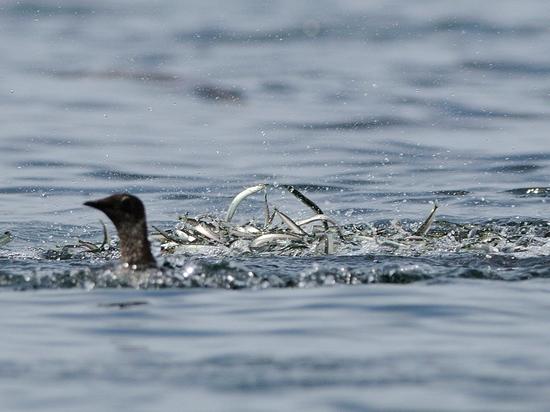
The Pacific sand lance is an important forage fish for marine birds, but little is known about its population status, largely because there is no directed fishery for the species. A recent study by Scott F. Pearson and colleagues at the University of Washington showed that breeding rhinoceros auklets on Smith and Protection islands in Washington State forage in the strait, and their diet patterns consist of 60–85 percent sand lance. Both wild and hatchery released juvenile Pacific salmon are also prey for marine birds in the strait, but there is little information on how bird use has changed in response to changes in abundances of juveniles within the ecosystem.
Historical changes in food webs can be inferred from studies on nitrogen isotopes in feathers because this can show the trophic level at which birds are feeding. The isotopic signature of the feathers grown before breeding can indicate if they are preying upon fish or further down the food web on invertebrates. Based upon a 150-year time series, using feathers from museum skins as well as from recent collections from live birds in Desolation Sound, researchers have learned that nitrogen-15 levels have declined in marbled murrelets over time. The lower values of nitrogen in more recent samples are consistent with fewer fish and more invertebrate prey in the birds’ diet. The same pattern of historical decline in trophic level was found in the diet of nestling marbled murrelets.
Recent research also confirms that the trophic feeding levels of glaucous-winged gulls in the strait have declined over the last 100 years. Modelling efforts by Louise Blight at UBC show that changes in clutch size and reproductive success are sufficient to account for the large increase of gulls in the strait from the turn of the century to 1986 and the subsequent decline to 1960 levels by 2010. These researchers argue that the decline could be caused by food limitation, but they could not discriminate between loss of fish prey food and the increase of poor quality food (availability of garbage). A recent thesis by Mikaela Davis at SFU, which studied the historical (1980) and present (2010) diets of gull adults and nestlings on Mandarte Island, showed a lower percentage of human refuse and an increase in fish in the 2010 samples.
The production of prey fish populations is also dependent on production of lower trophic levels like zooplankton, which are themselves linked to phytoplankton production. Scientists at the University of British Columbia and Institute of Ocean Sciences have observed advancement in the timing of spring phytoplankton bloom in recent years, which may be linked to ocean climate change. The timing of spring peak abundance for one of the largest and most important copepod prey species in the strait is thought to be earlier by up to 50 days from 1968 to 2006, and this change may cause the zooplankton prey to become mismatched with the timing of their predators. In addition to the timing changes, abundance hit a historical low in 2006, according to John Dower’s research group at the University of Victoria, although the research of Dave Mackas and colleagues at the Institute of Ocean Sciences shows that it has subsequently recovered. However, all efforts to evaluate the impacts of ocean climate variability on food webs and upper trophic level predators are hampered by the difficulty of separating natural variability from human-induced changes. For example, many sea ducks eat shellfish during the winter, and in the 1990s an introduced species, the varnish clam, took hold in Baynes Sound and became a major component of the diet of surf and white-winged scoters. Centre for Wildlife Ecology researcher Dan Elser concludes that scoter numbers have doubled in Baynes Sound since 1981 as a result of the increased food quality and quantity.
Threats to Birds from Humans
There are many past, present and future human-related threats to birds, their habitats, and the food webs of the Strait of Georgia ecosystems, and the following is a brief overview of those that must be considered in determining the mechanistic causes of bird population changes (table 1). However, although this section concentrates on the strait, similar threats occur in other habitats and ecosystems on which migratory birds rely during their annual life cycle. A recent study by the Puget Sound Institute, based at the University of Washington, has addressed and ranked regional threats to the Puget Sound ecosystem, and the institute is now working to establish a web-based Encyclopedia of Puget Sound to aid in conservation decisions.
Human population growth
The growth of human populations is an important factor in bird population changes in both the Strait of Georgia and Puget Sound. As the urban regions grow and humans occupy more and more coastal places, marine bird habitats are being lost due to the increasing ecological footprint. In the strait, it is the human impact on estuaries that is most obvious, and according to a working group on nearshore habitat loss, by 2001 approximately 23 percent of the nearshore has already been urbanized. The remaining bird habitats and the prey populations they support can become degraded as a result of pressures and threats from activities associated with human population growth and industrial expansion.
Toxic compounds
For decades prior to 1970 the pesticide DDT was commonly used in agriculture and around homes, biomagnifying and progressing into the food chain of predators such as bald eagles and peregrine falcons and causing the shells of their eggs to thin. The result was reproductive failure and population declines. The banning of DDT in the 1970s contributed to the rise in raptor populations worldwide, but especially so in the Strait of Georgia. However, between the 1950s and 1970s many areas in south coastal British Columbia may also have had sufficient levels of PCBs to impair eagle reproduction, and much of these PCBs were contained in the effluents coming from pulp and paper mills. Research on bald eagles, great blue herons and double-crested cormorants by wildlife toxicologist John E. Elliott and his partners at the Pacific Wildlife Research Centre in Delta, BC, was vital in bringing about changes in regional pulp and paper processing. Poisoning of eagles from ingesting lead shot found in waterfowl prey (ducks, geese and swans can consume old lead shot while foraging) influenced the decision to ban lead shot in hunting. The historical bounty for eagles in Alaska may also have reduced the overall “metapopulation” because Alaska, British Columbia and Washington birds winter together as they move to track prey populations. Loss of old-growth nesting trees may also have had historical impact on eagle populations as well.
Oiling of birds
Even a small amount of oil can result in bird mortality by preventing feathers from insulating and causing death from hypothermia. Shipping is a constant threat to birds because of the risk of chronic oiling from the illegal discharge of oily bilge water as well as catastrophic spills. Patrick O’Hara, a scientist with the Canadian Wildlife Service’s Birds Oiled at Sea Program, tracks shipping and associated pollution and works with other agencies to deter chronic oiling. The frequency of larger oil spills is directly related to the amount of shipping activity, and oil tanker traffic in the strait is projected to increase from five to thirty-four tankers per month as soon as the capacity of the Trans-Mountain Pipeline carrying crude oil from Edmonton to Burnaby is increased. Large refineries at Cherry Point at the southern end of the strait service roughly twelve oil tankers per month as well as many other oil-carrying vessels. In the last 15 years diesel fuel or bunker oil has been spilled twice in Vancouver’s harbour and once into the Fraser estuary; in the same period canola oil has been spilled into Burrard Inlet five times, resulting in the oiling of waterbirds.
Harvesting
The introduction of the Migratory Birds Convention Act in both Canada and the United States in 1917 enforced regulations and restrictions on hunting, egg harvesting (egging) and the disturbance of migratory birds. The associated reduction in hunting pressures was especially marked for species such as the trumpeter swan, which increased since 1933 when there was an all-time low in the United States and only a few birds left on the British Columbia coast and near Grand Prairie, Alberta, to over 23,000 birds in 2000 when the Strait of Georgia became a key wintering area. Declines in sport harvesting since 1987 have also contributed to the doubling of snow geese overwintering on the Fraser delta to 60,000–100,000. Reductions in egging since the introduction of the Migratory Birds Convention Act may also have contributed to historic increases in glaucous-winged gull populations.
Fishing
The historic overfishing of herring and closure of that fishery in 1967 had an important impact on marine bird populations in the strait as birds have demonstrated such responsiveness to tracking the recovered herring populations. However, other fishing problems remain. Entanglement in gillnets results in a loss of birds; beached bird surveys reveal that mortality of common murres and rhinoceros auklets can occur in August in Boundary Bay. Neither Canadian nor American gillnet fisheries are generally restricted from fishing among birds, and the regulations that are in force are hard to monitor; however, the San Juan area has been closed to gillnet fishing because of entanglement risks specifically to the marbled murrelet. Lost fishing gear such as nets and traps causes mortality to diving birds as well as to marine mammals and many fishes and invertebrates.
Waste management
Historically, open landfills near urban areas in the strait may have had an influence on gull population growth, but it is difficult to separate the effects of junk food from garbage versus changes in prey populations. Today recycling programs are strong in BC, and garbage is handled differently than in the past. In fact, in 1999 the Hartland Landfill, operated by Victoria Central Regional District, won a climate change award for capturing methane gas emission from the city’s landfill. Plastic items adrift in the oceans are becoming a worldwide problem, and the Georgia Basin is no exception. Plastics degrade foraging habitats and may become concentrated in the crop of birds, causing health problems and potential death.
Disturbances by humans
The serious nature of bird problems resulting from boat disturbance was recognized as early as 1951 by Rudy Drent and Charlie Guiget in their catalogue of seabird colonies in the Strait of Georgia. Waterbirds are vulnerable to disturbances from shipping vessels and even from recreational boaters, rowers and kayakers; a passing kayak that disturbs feeding scoters has interrupted feeding time that is vital to their migration preparations. Disturbance of nesting cormorants often results in nest abandonment or egg predation by gulls and crows. The decline of great blue herons in the strait may be related in part to increasing disturbances to their colonies. Modern jet skis are uncommon on the strait, but birds such as western grebes, which nest on inland lakes, are very susceptible to such disturbances. Dogs are also a disruption, as they cannot resist the thrill of the chase. The Brant Festival in Parksville does a great job of educating people to the problem of dog disturbance and actively prohibits dogs in certain areas. Currently there are no legislated guidelines for approach distances to birds, such as are in place for viewing marine mammals.
Climate change
The Department of Fisheries and Oceans Canada produces an annual report on the state of the Pacific Ocean, charting ocean climate variability and its impacts on the Strait of Georgia ecosystem. From this we know that the strait continues to warm, and the resulting acidification could negatively impact prey populations for birds. In addition, the sea level is predicted to rise, and the increase could cause habitat loss that would affect shorebirds that rely on estuaries as well as those—such as western sandpipers—dependent on mud and sand flats. However, climate change impacts on wildlife are difficult to evaluate because of the problem of separating human-influenced changes from natural climate variations, such as El Niño, and other longer-term cycles, like the Pacific Decadal Oscillation. The strait is a particularly complex ecosystem because it is an inland sea that is affected by Fraser River flows as well as offshore ocean and climate conditions.
There are several traits that increase bird groups’ vulnerability to human-induced threats. A key factor is that they winter or migrate along coasts in large numbers, increasing their vulnerability because they are concentrated. Nesting colonies are also at high risk to some types of threat, and seabirds and other long-living species that have delayed maturity or lay single egg clutches may be slower to recover from losses. As a result, preventing detrimental population changes requires investigating top down effects, bottom up effects, and threats from humans to birds and to their habitat. Integrated ecosystem research of bird populations and their prey populations is required to identify the key causes of declines. If these are found to be related to human activities, then we must determine what can be done to prevent further bird losses and how to mitigate losses caused by accidents.
Legal Protection and Conservation
Many legal acts and regulations have been enacted at various levels of government within Canada and the US that impact birds, their habitats and prey populations in the Strait of Georgia (see table 2). The Migratory Birds Convention Act, passed in 1917 to protect species whose populations had been reduced by market hunting and overharvesting, is the pertinent act governing both Canada and the United States. Unless permitted by other regulations, this act states that it is “unlawful to pursue, hunt, take, capture or kill; attempt to take, capture or kill; possess, offer to or sell, barter, purchase, deliver or cause to be shipped, exported, imported, transported, carried or received any migratory bird, part, nest, egg or product, manufactured or not.” Some bird groups and species were not listed by the federal act (see table 3), but they are currently protected under provincial or state legislation. The act and its regulations were amended and strengthened in 1994 to include Bill C15 in order to enable the Birds Oiled at Sea Program to be linked to illegal discharges of oily bilge water under the Shipping Act.
The Fisheries Act, which has legislation in place to protect fish habitat, promote stock conservation and license and conduct fisheries, is also relevant to birds and their habitat as ecosystem management requires considerations of both prey and predator populations. A 2011 paper in the prestigious international journal Science recommends that fisheries managers conserve “one third for the birds.”
The Canadian Environmental Assessment Act requires that large projects on federal lands must be subjected to the federal environmental assessment process linked with the implementation of the British Columbia Environmental and Land Use Act. The United States Environmental Protection Act guides that country’s federal regulatory agencies, which recently ranked nearby Puget Sound as one of the top ten locations in the nation in need of restoration.
When a regulatory act is referenced, and it is determined that migratory birds have been killed, funds to mitigate the damages can be used to enhance habitats anywhere the species resides. For example, in 1989 when marine birds in Canada were killed by oil leaked from the damaged barge Nestucca in Washington State, the settlement funds were used largely to eradicate rat predators that had been introduced to the ancient murrelet colony on BC’s Langara Island in northern Haida Gwaii. That population is currently recovering, and some of those birds may have been among the record number of 27,000 observed in the strait in January 2012.
When either Canada or the United States is party to international treaties to protect migratory birds and their habitat, such as Rio 2010 on Biodiversity, the Ramsar Convention on Wetlands or the Convention on International Trade in Endangered Species, the acts and regulations within each country are the tools used to achieve their goals.
Table 2. Legal acts, application to birds and their habitats, and responsible agencies in Canada
Ownership of Terrestrial and Marine Habitats
In Canada the federal Migratory Birds Convention Act applies to birds, but the land on which bird habitats are found is largely owned by the provinces, territories, First Nations (many treaty negotiations are ongoing) or private citizens. On the BC coast, federal parks and lands make up less than 5 percent of the land base; this is also true in the Strait of Georgia where 95 percent of the land is not federally owned. The east coast of Vancouver Island is unusual because it is mostly private lands. In Washington State, in contrast, there are considerable amounts of federal land in addition to state, tribal and private lands along the coast.
The Province of British Columbia owns all the land between the high and low water mark on the west coast and the seabed between major headlands. The federal government owns the waters, the seabed substrates and the organisms that make up those habitats, such as eelgrass, mussel beds and oyster reefs. However, the Strait of Georgia is a notable exception as the result of a supreme court ruling in 1984 that confirmed that British Columbia, rather than Canada, owns the seabed in the strait. (Note that the Nanoose Bay seabed was expropriated from the Province in 1999 by the federal Department of Defence.) Coastal shores jurisdiction in BC for the provincial, federal and local governments and First Nations has been neatly summarized by Green Shores, a project to promote sustainable use of coastal ecosystems through planning and design. Washington State has a Coastal Zone Management Program that outlines jurisdiction for state, federal, tribal and private coastal areas, but in marked contrast to British Columbia, it is one of two states where owners of adjacent land have full title over beaches and the submerged seabeds. Regional districts and municipalities in British Columbia and counties in Washington State can also lease or own coastal lands and may work in partnership with higher levels of government.
Protected Areas and Habitats
Within the Strait of Georgia on both sides of the international boundary there are many types of protected and conservation areas for birds and bird habitats on land, along the coastline and in the ocean. Provincial and state parks are a common form of protected areas, and some parks, such as Mandarte Island in British Columbia and Smith Island in Washington State, provide primary habitats for a variety of marine birds. Desolation Sound Marine Park is an important foraging area for marbled murrelets. The provincially designated Parksville–Qualicum Beach Wildlife Management Area protects beach foraging habitat for wintering and migrating brant geese. Shoal Harbour on Saanich Peninsula near Sidney is a federal migratory bird sanctuary and an essential protected area for wintering and migrating birds, waterfowl in particular. The Reifel Migratory Bird Sanctuary and adjacent Alaksen National Wildlife Area on Westham Island in the Fraser River delta provide important habitats for wintering snow geese and other waterfowl. Alaksen was designated in 1982 as a wetland of international importance under the Ramsar Convention (1971), which is charged with “the conservation and wise use of all wetlands through local and national actions and international cooperation, as a contri-bution towards achieving sustainable development throughout the world.” The Qualicum National Wildlife Area protects part of the Little Qualicum River estuary. A new federal park, the Gulf Islands National Park Reserve, provides important nesting habitat for black oystercatchers and many migrating shorebirds, such as western sandpipers, surfbirds and black turnstones. Discussions are underway with the Province of BC to form a Southern Strait of Georgia National Marine Conservation Area Reserve in the seas surrounding the federal parklands in the Gulf Islands. A pilot marine protected area has been established in Gabriola Channel by Fisheries and Oceans Canada. The not-for-profit Salish Sea Foundation has recently suggested the formation of the Salish Sea Marine Sanctuary, North America’s first international marine sanctuary, encompassing the Strait of Georgia, Puget Sound and Juan de Fuca Strait.
Since 1976 the United States Fish and Wildlife Department’s national wildlife refuge system has protected significant habitats in the southern part of the strait. The 182-ha San Juan Islands Refuge, which consists of eighty-three rocks, reefs, grassy islands and forested islands in northern Puget Sound, was set aside to protect colonies of nesting seabirds, such as pigeon guillemots, double-crested cormorants and pelagic cormorants. All but two of the islands are closed to the public.
Although estuaries are essential habitats for birds, a 2001 report found that less than 4 percent of coastal wetlands and estuaries on the strait were protected under federal and provincial legislation. In 1998 a 78-ha farm adjacent to the Courtenay River estuary in the Comox Valley was purchased through the Pacific Estuary Conservation Program to conserve a valuable wintering habitat for trumpeter swans and to generate regional waterfowl conservation projects. In 2009 the 200-ha Chemainus estuary, the second most important estuary in the strait (after the Fraser), was bought for $3 million by the international conservation organization Ducks Unlimited Canada in order to conserve critical migratory habitat for waterfowl. The purchase was made through the Pacific Estuary Conservation Program in consultation with the North Cowichan Regional District and the three First Nations groups in the area. The deal was accomplished with the assistance of the vendor (Catalyst Paper Corporation), the British Columbia Trust for Public Lands and the United States Fish and Wildlife Service, which matched donations. South of the border the 32 km2 Padilla Bay National Estuarine Research Reserve is managed by the Washington State Department of Ecology in cooperation with the Office of Ocean Research Management, which is part of the National Ocean and Atmospheric Administration (NOAA).
The Mount Arrowsmith Biosphere Reserve was so designated in November 2000 by the United Nations Educational, Scientific, and Cultural Organization (UNESCO). It includes the City of Parksville, the Town of Qualicum Beach, portions of the Regional District of Nanaimo, all of the watersheds flowing into the strait between Lantzville and Dashwood on Vancouver Island, plus the adjacent waters, including the Ballenas/Winchelsea islands. Biosphere reserves are recognized internationally as demonstrating practical approaches to balancing conservation and development. They must include one or more protected areas, such as a national park or a national wildlife area for the conservation of ecosystems and native biodiversity and act as a buffer area in which activities compatible with the conservation area occur. This type of reserve is a large area of cooperation where sustainable resource management practices are promoted and developed. The internationally significant Western Hemisphere Shorebird Reserve Network (WHSRN) includes the Fraser River estuary mud flats of Roberts Bank and Boundary Bay. This Fraser River delta site is one of sixteen major wetlands identified between the breeding grounds in Alaska and the overwintering grounds in the Upper Bay of Panama.
Bird Studies Canada, under the criteria developed by BirdLife International, has identified more valuable bird areas in the Strait of Georgia. The biosphere and shorebird reserves, Ramsar site and important bird area habitats are not formally protected by law over and above the existing legislation. However, they do focus the attention of conservation agencies.
Conservation, Stewardship, Restoration, Research and Monitoring Efforts
Conservation efforts in the Strait of Georgia include land acquisition, habitat restoration, stewardship, ecosystem oriented research, monitoring, and ongoing implementation, evaluation and adaptive management of programs. To help achieve the conservation objectives of the Migratory Birds Convention Act, federal departments in Canada and the United States have formed partnerships and developed cooperative agreements with universities, public groups, private foundations, industries, First Nations and tribes and all levels of government (self, municipal, provincial and federal). The federal government has entered into successful conservation research partnerships with the Centre for Wildlife Ecology at SFU and the Centre for Applied Conservation Research at UBC as well as the Coastal Observation and Seabird Survey Team at the School of Aquatic and Fishery Sciences at the University of Washington. These university partnerships bring cutting edge research applications to real-world problems faced by the agencies mandated with the conservation of birds and their habitats.
The conservation of habitat for listed species is promoted through stewardship and restoration agreements under the Canadian Species at Risk Act. In 1986 the acquisition of land for the purpose of sustaining waterfowl populations was facilitated by Canada–US cooperation in the formation of a North American Waterfowl Management Plan, which secured four million hectares of waterfowl habitat between 1990 and 2010. Under the regional Pacific Coast Joint Venture, the Pacific Estuary Conservation Program, which was established in 1987, intends to acquire and enhance important estuarine habitats in BC. It is currently in partnership with Environment Canada (Canadian Wildlife Service), Fisheries and Oceans Canada, the British Columbia Ministry of Environment, the British Columbia Habitat Conservation Trust Fund, Ducks Unlimited Canada, the Nature Conservancy of Canada, the Nature Trust of British Columbia and the Land Conservancy of British Columbia. The 2009 purchase of the 200-ha Chemainus estuary by Ducks Unlimited Canada is part of the Pacific Estuary Conservation Program.
A notable stewardship and restoration program focusing on the removal of lost fishing nets and traps is underway in the US portion of the Strait of Georgia and in Puget Sound. The Northwest Straits Marine Conservation Initiative, which unites federal, state, county and tribal groups with private citizens, employs a vessel and divers to identify and remove lost gear and document impacts on wildlife. This program has removed thousands of old crab pots littering the seafloor and hundreds of abandoned nets caught in rocky outcroppings or draped along waterways. Lost nets and pots continue to catch fish and kill birds, mammals and sea life long after they have gone adrift.
Citizen science programs are also gaining momentum in the strait with techniques being shared by Canadian and US teams. For example, the Coastal Waterbird Survey by Bird Studies Canada uses the same techniques as the Seattle Audubon Society. The Coastal Observation and Seabird Survey Team Program and Bird Studies Canada also employ similar techniques for beached bird surveys, and a Breeding Bird Atlas for British Columbia is forthcoming from Bird Studies Canada. Its content is based largely on observations from citizen science.
In addition to local natural history societies, other environmental societies and groups contribute to bird conservation through monitoring and research. Educational material on waterfowl migration is provided by the British Columbia Waterfowl Society, which runs the Reifel Bird Sanctuary on Westham Island. Each year the Nature Trust of British Columbia hires two members of the Black Brant Conservation Crew to carry out public education, monitoring and observing, recording and reporting human and/or dog activities that might disturb black brant within the Parksville–Qualicum Beach Wildlife Management Area. The British Columbia Purple Martin Stewardship and Recovery Program is run by a charitable non-profit society. Examples of marine-related grassroots groups who work on forage fish prey populations and habitats include the Beach Spawners Alliance and the Eelgrass Society and Mapping Network. Professional scientific societies have mandates that bring national and international attention to conservation of bird populations and their habitats. The Pacific Seabird Group, Waterbird, Waterfowl and Shorebird societies are international groups that have broader linkages to overarching conservation agencies such as BirdLife International and the American Bird Conservancy.
Conclusion
The Strait of Georgia provides essential habitat for millions of migratory birds, and as their life cycles are interconnected, so too are the diverse habitats that support their seasonal needs. As a result, in order to conserve vital bird populations, it is necessary for us to understand all stages of their annual cycle. Equally important is the need to be aware of the ecological conditions that should ideally exist in the variety of habitats connected by the birds during migration, reproduction and wintering. We can begin to make a positive difference simply by recycling plastics and controlling dogs, and as we become more aware of the basic needs of the diversity of birds inhabiting this region, we will begin to understand how crucial the conservation of all these ecosystems is to the overall health of the strait. In Britain, the Royal Society for Bird Preservation has over a million members; if we were to give binoculars to all the children living in this region, in the future we too might have a nation more fully aware of the critical needs of our migratory birds.
Table 3. Coastal birds of the Strait of Georgia.
[To Top] [To Contents]
